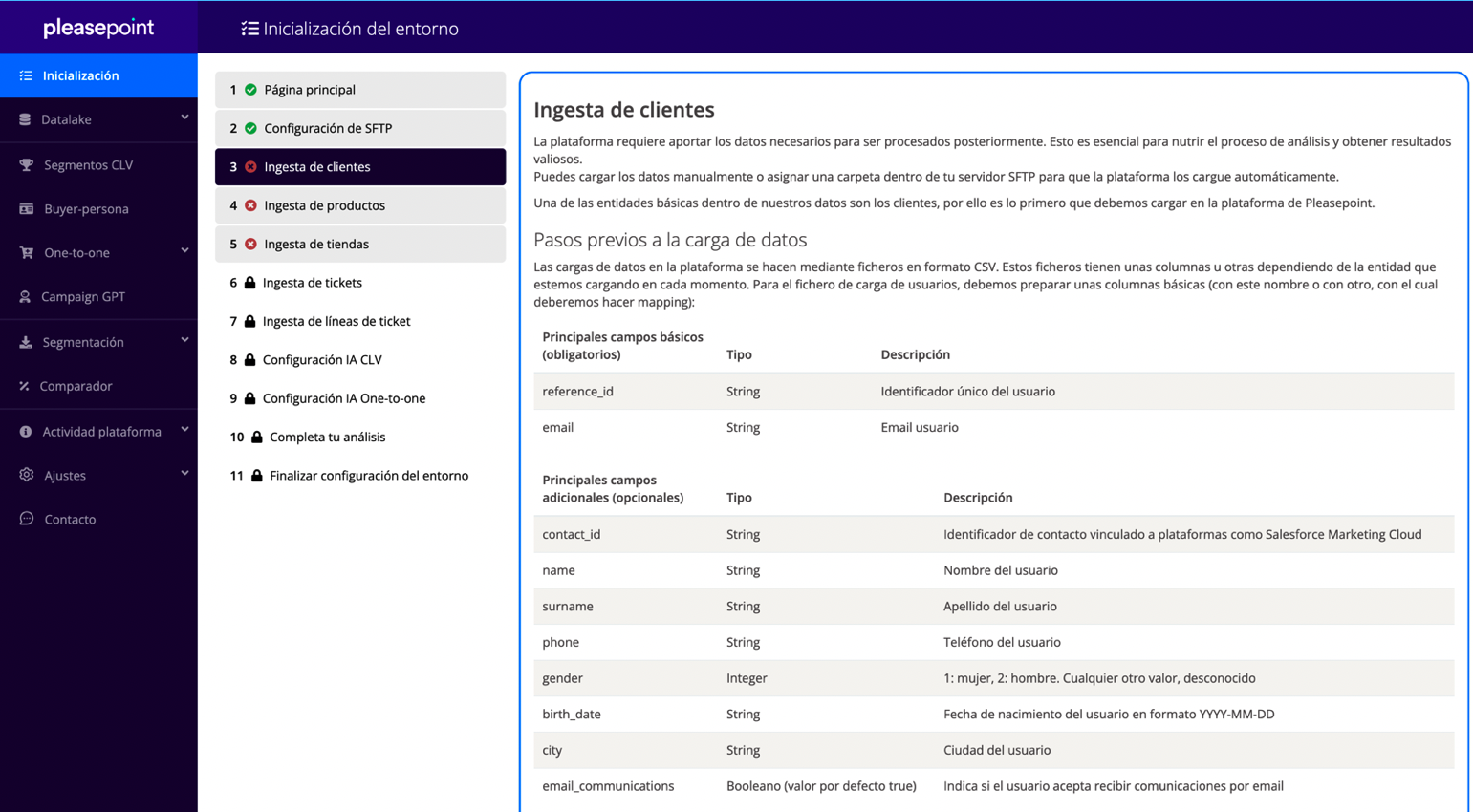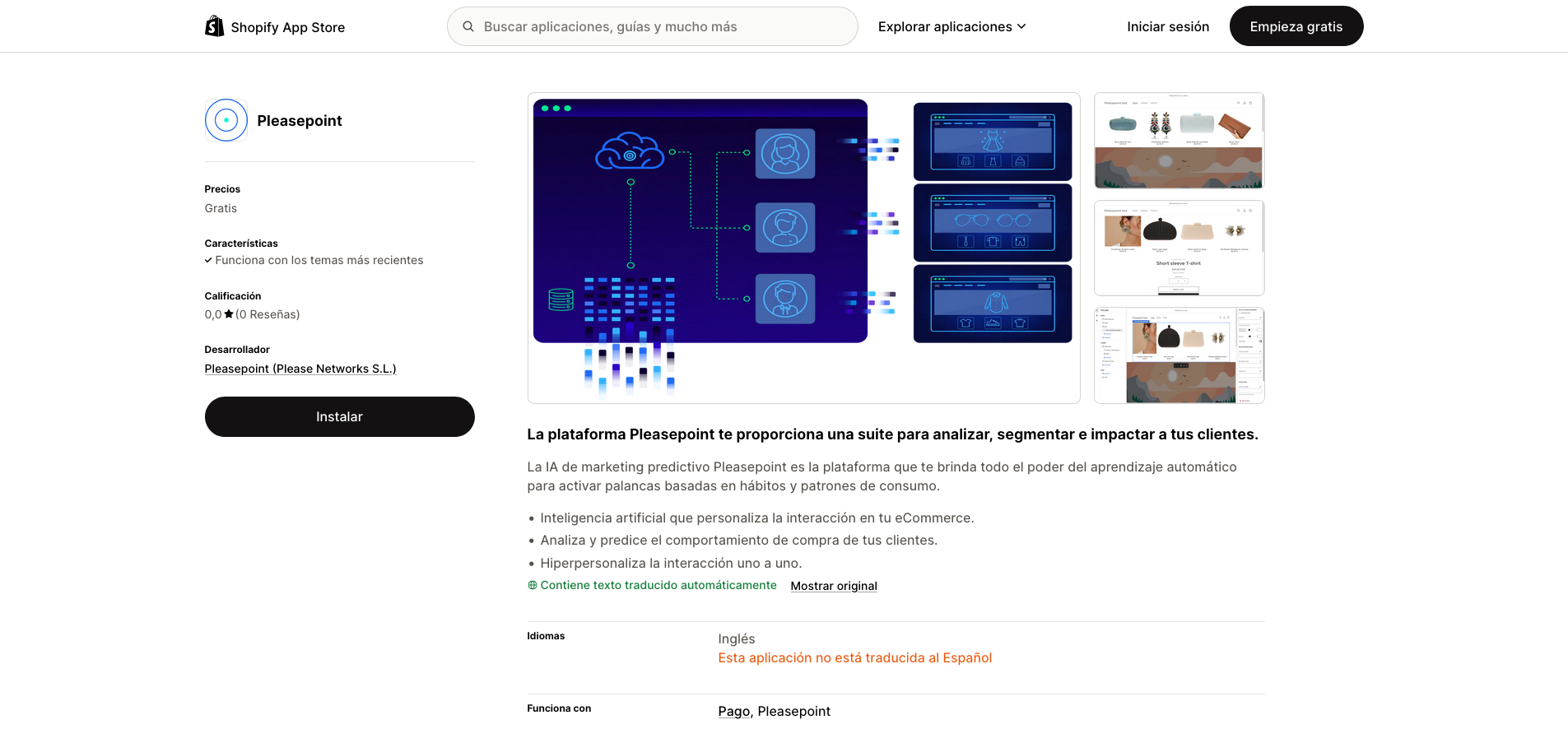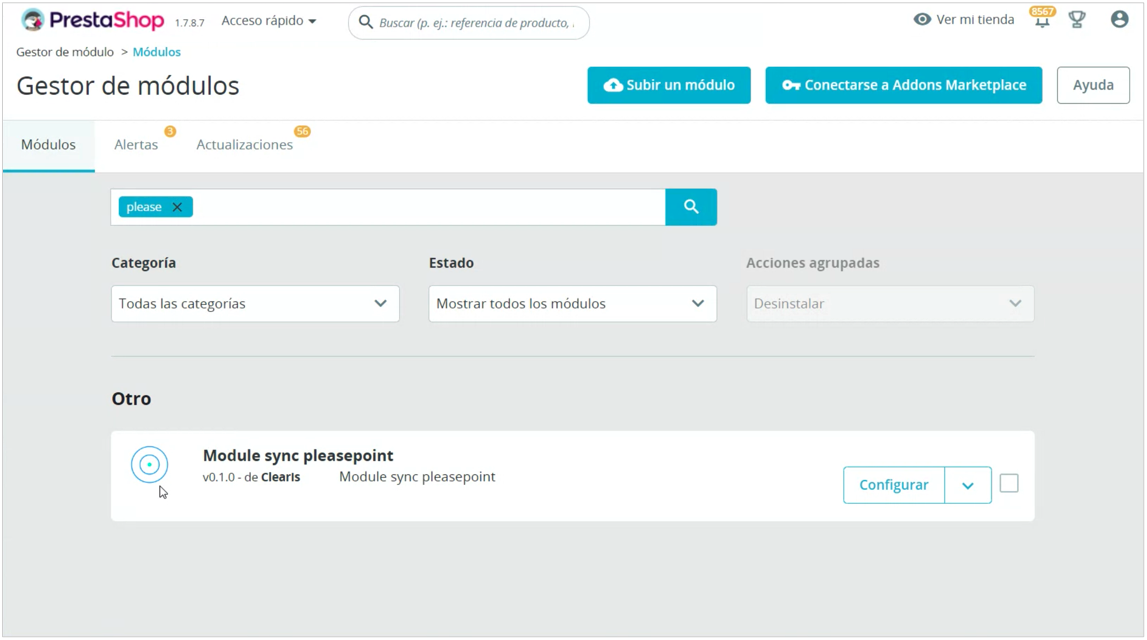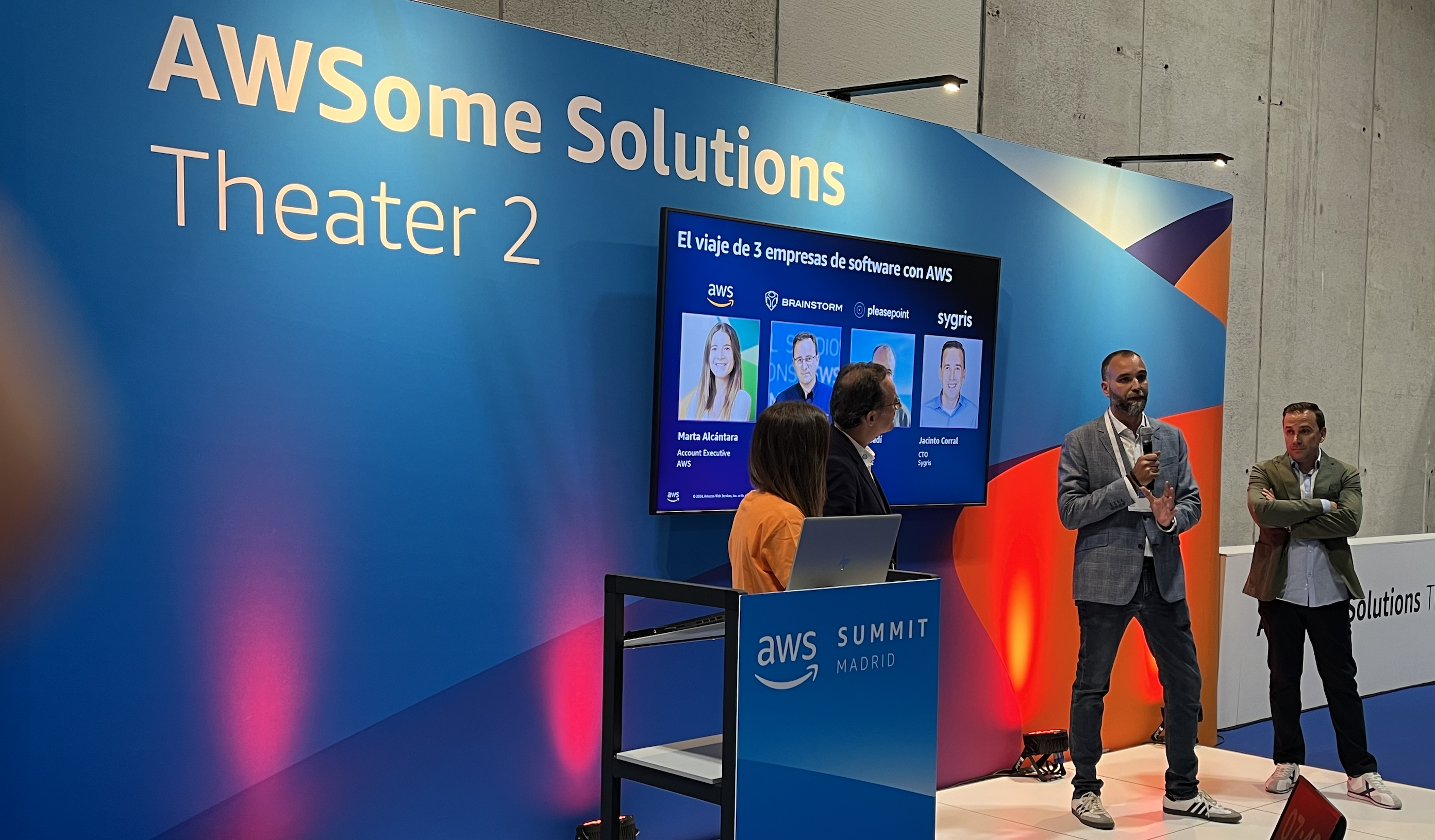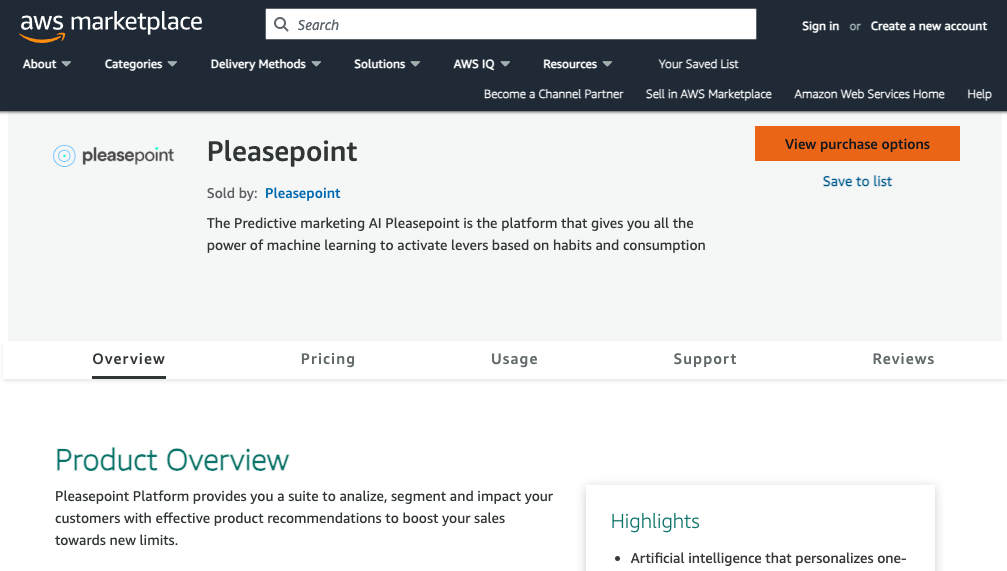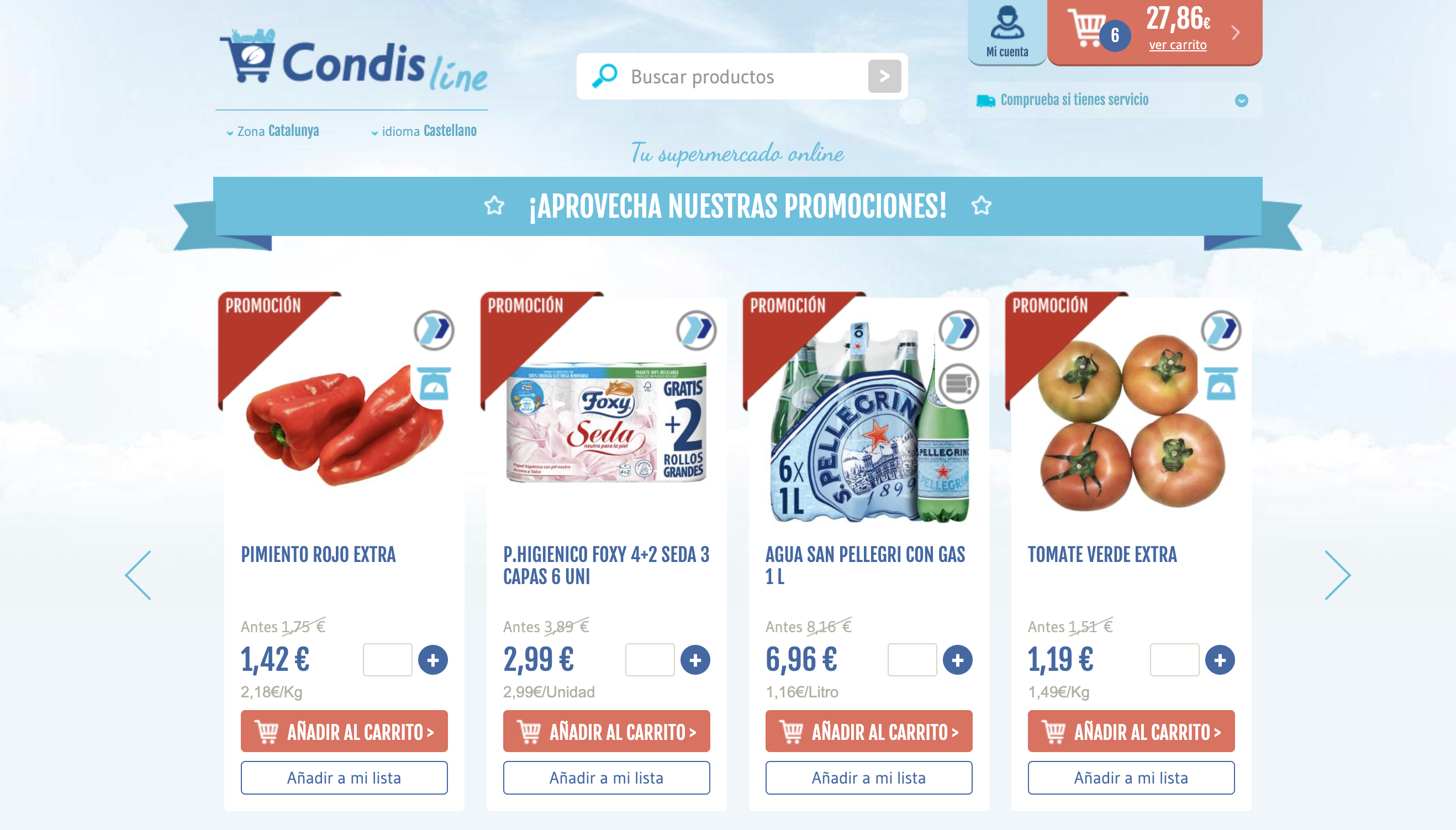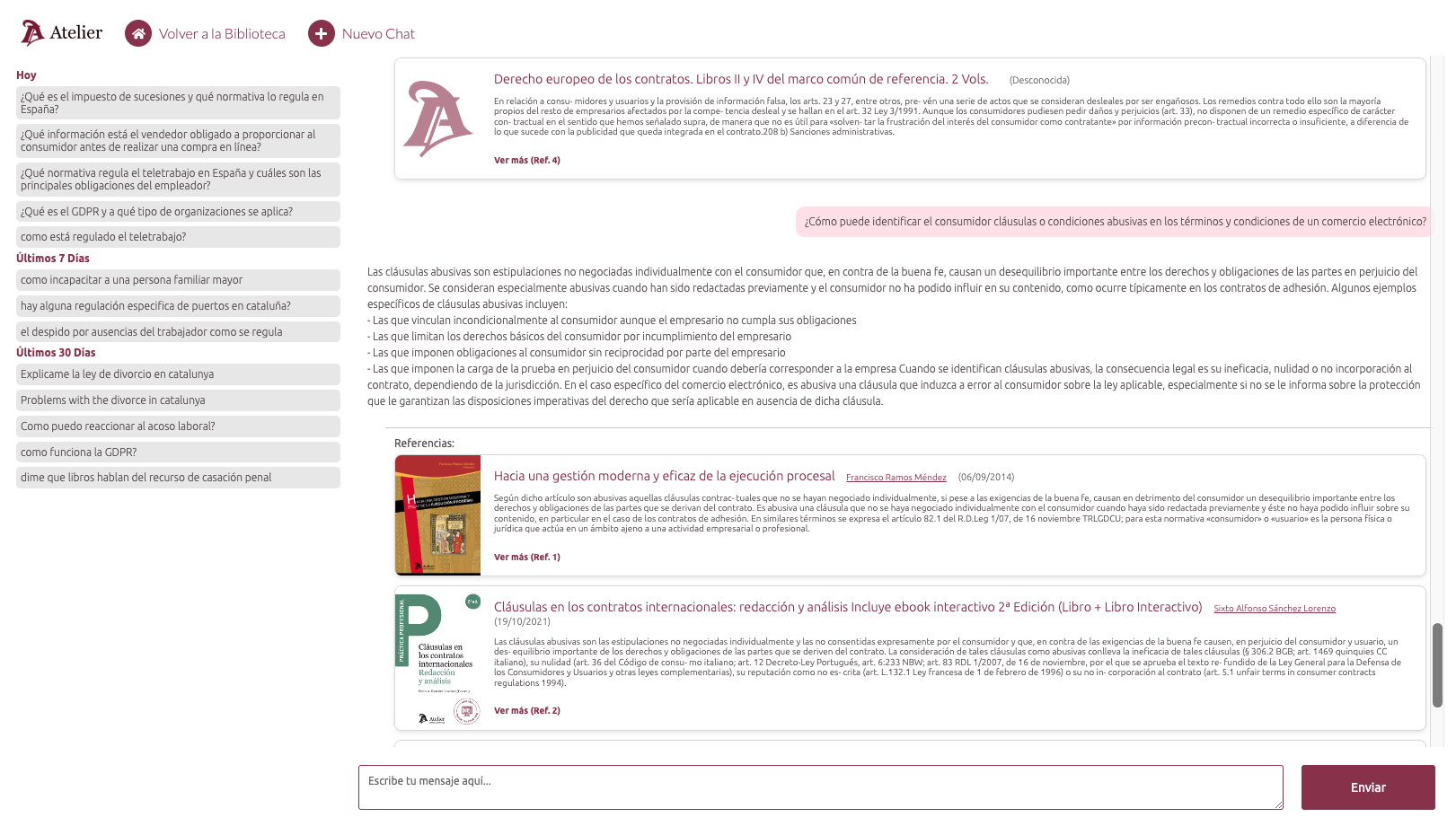Predictive marketing has become a fundamental pillar for eCommerce, CRM strategy, and digital advertising. However, for many, it may seem like an overwhelming challenge.
In this article, we will guide you through the first steps into the world of Pleasepoint, where audience micro-segmentation and real-time hyper-personalization of interactions become accessible and effective.
These are the contents of the article
- Benefits of predictive marketing
- Onboarding process in Pleasepoint.
- Available Artificial Intelligence models.
- Start now by implementing these use cases.
Predictive marketing has become a driving force in the world of eCommerce, CRM strategy, and digital advertising. Are you wondering how to take your first steps in this exciting journey towards hyper-personalization?
Let me share five previous blog articles that I think you might find interesting:
- Tips for creating a profitable customer loyalty club.
- Transforming data into sales increases: A success case of hyper-personalization in CRM strategy..
- Maximizing conversion and loyalty through personalization..
- The control group: The key to measuring the impact of your CRM actions.
- How to drive product replenishment with hyper-personalization?
- How often should I send emails to customers?
- Pleasepoint selected at AWS Summit Madrid 2023 as one of the 20 most innovative startups.
Benefits of implementing a predictive marketing strategy.
In this article, we will guide you through the first steps in Pleasepoint, the leading predictive marketing platform. Discover how you can start leveraging the power of prediction and personalization to boost your marketing strategy.
Remember that with Pleasepoint, you can segment customer audiences, hyper-personalize your actions, and measure results easily and user-friendly, without the need to dive deep into data analysis. Our machine learning-based platform does it for you.
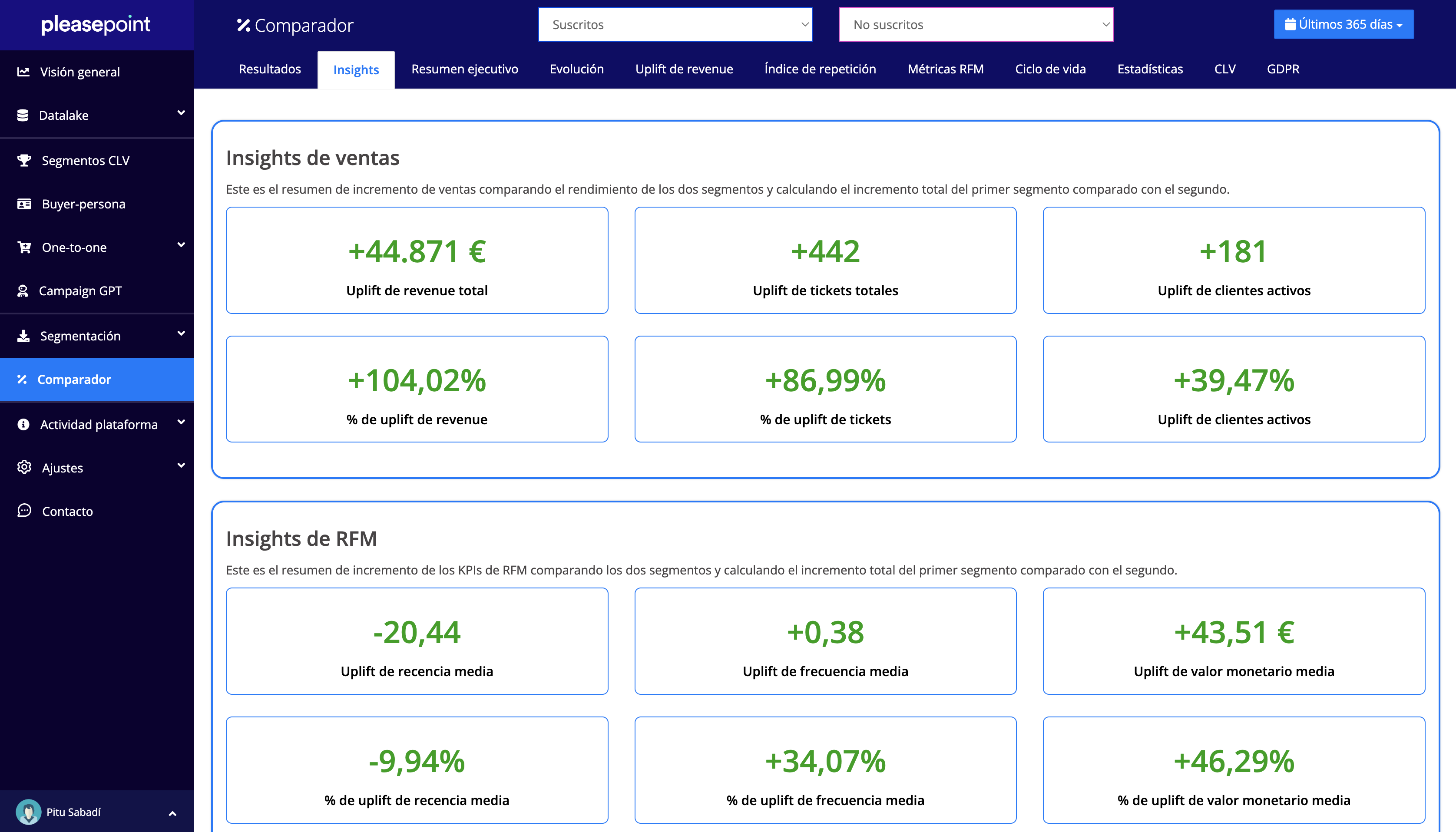
Listing the benefits of predictive marketing in different areas can be highly enlightening. Here are five key advantages of using predictive marketing in your CRM strategy:
- More precise segmentation: Predictive marketing allows you to divide your customer base into more specific segments based on their past behavior and preferences. This makes it easier to deliver more relevant and personalized messages.
- Better customer retention: By better understanding your customers' needs and desires, you can implement more effective strategies to retain them. This is especially important in a market where customer loyalty is a valuable asset.
- Increased customer satisfaction: By offering your customers what they want, you increase their satisfaction. A satisfied customer is more likely to stay with you and become an advocate for your brand.
- Resource optimization: By directing your efforts and resources toward customers with a higher likelihood of purchase, you maximize the efficiency of your marketing campaigns and reduce resource wastage.
- Higher return on investment (ROI): By delivering more relevant messages to the right people, you increase the chances of conversion. This translates into a higher ROI for your marketing efforts.
Now, let's take a look at how predictive marketing can enhance the shopping experience in eCommerce:
- Personalized recommendations: By using predictive marketing algorithms, you can offer highly relevant product recommendations to your customers, increasing the likelihood of additional purchases.
- Improved user experience: Personalization based on customer behavior can improve the overall shopping experience, making customers feel valued and understood.
- Reduced cart abandonment: By understanding the reasons behind cart abandonment, you can take proactive steps to reduce this metric and increase conversions.
- Price optimization: Predictive marketing can help you dynamically adjust prices based on demand and competition, which can increase your profit margins.
- Increased customer loyalty: Personalization and improved shopping experiences foster customer loyalty, making them more likely to return and make repeat purchases.
Finally, in the realm of digital advertising, here are five ways predictive marketing can make a difference:
- Precise audience segmentation: Predictive marketing allows you to identify the audiences most receptive to your ads, increasing the effectiveness of your advertising campaigns.
- Bid optimization: You can personalize ad offers in real-time based on user behavior, increasing the likelihood of conversion.
- Reduced impression wastage: By targeting the right audiences, you avoid spending on ineffective impressions, improving the efficiency of your campaigns.
- Improved CTR (Click-Through Rate): By showing highly relevant ads, users are more likely to click on them, improving your click-through rates and the quality of your leads.
- Increased customer retention: Using predictive marketing in advertising, you can foster retention of existing customers by showing them relevant ads and special offers.
These are just a few of the benefits of predictive marketing in different areas of your business strategy. As you dive deeper into the world of predictive marketing, you'll discover even more ways it can drive your success.
If you want to see a full success case on personalization, I recommend this post: In this post, we show the results of one of our clients from August.
Onboarding process in Pleasepoint.
The onboarding process in Pleasepoint is the crucial first step to making the most of this powerful predictive marketing platform. Here, we will guide you through the various steps you need to follow to set up your platform and be ready to micro-segment your customers and hyper-personalize real-time interactions. Let's get started!
Step 1: Start of Onboarding
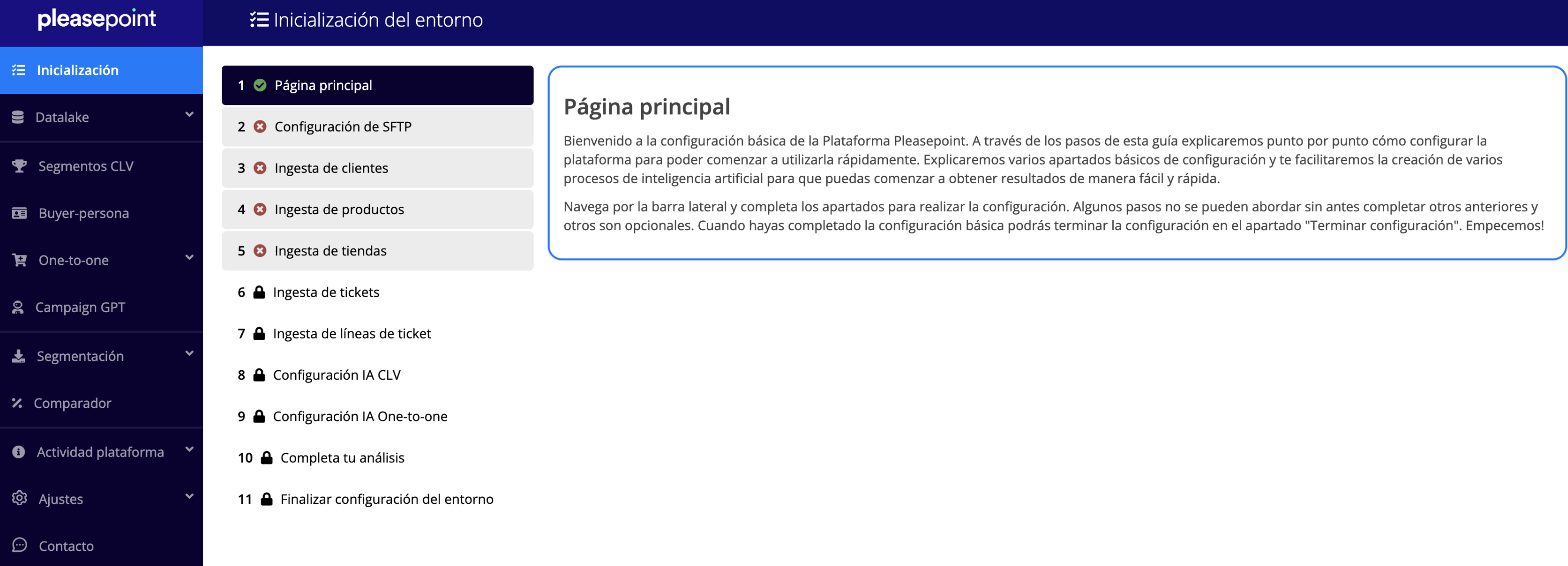
The first step of onboarding is explanatory, providing context and understanding why you're taking these steps.
Step 2: sFTP Connection Setup
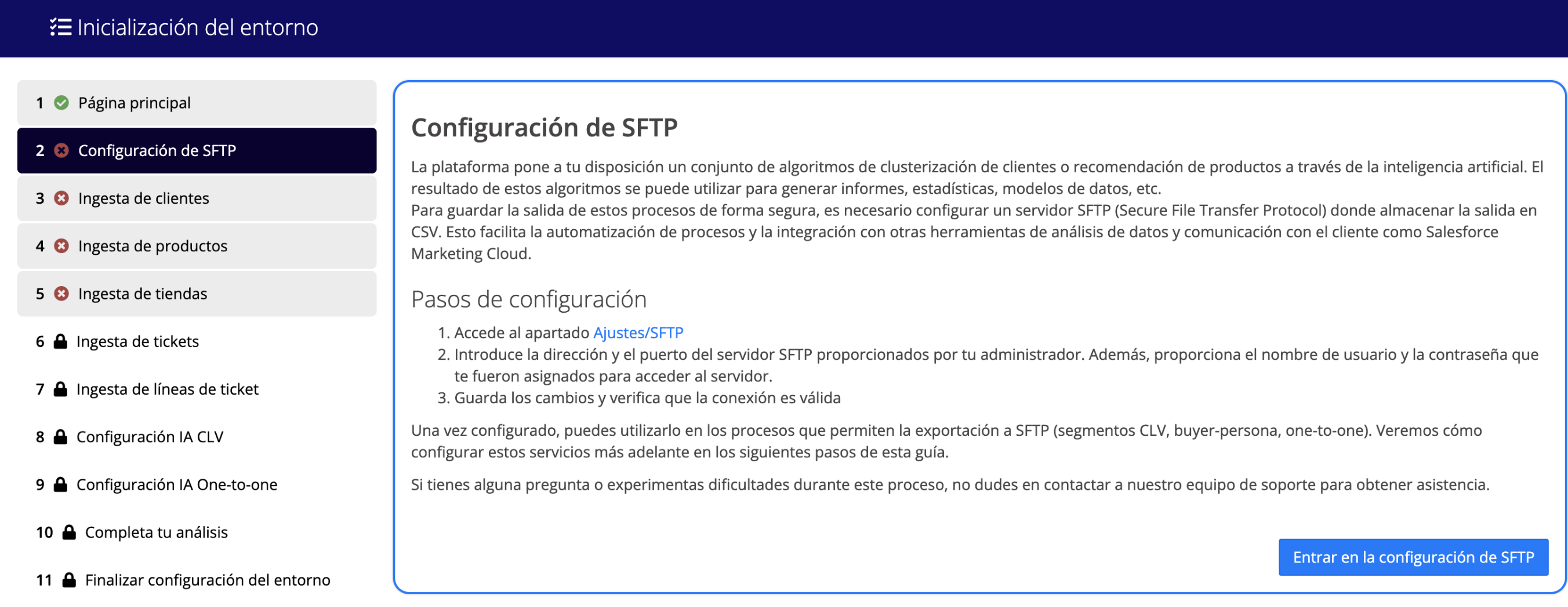
To make the most of Pleasepoint's artificial intelligence models by exporting data to your CRM, you need to set up an sFTP (Secure File Transfer Protocol) connection.

This will allow you to securely store the results of these algorithms in CSV format. This setup is essential for process automation and integration with other data analysis and customer communication tools, such as Salesforce Marketing Cloud.
Step 3: Customer Data Ingestion
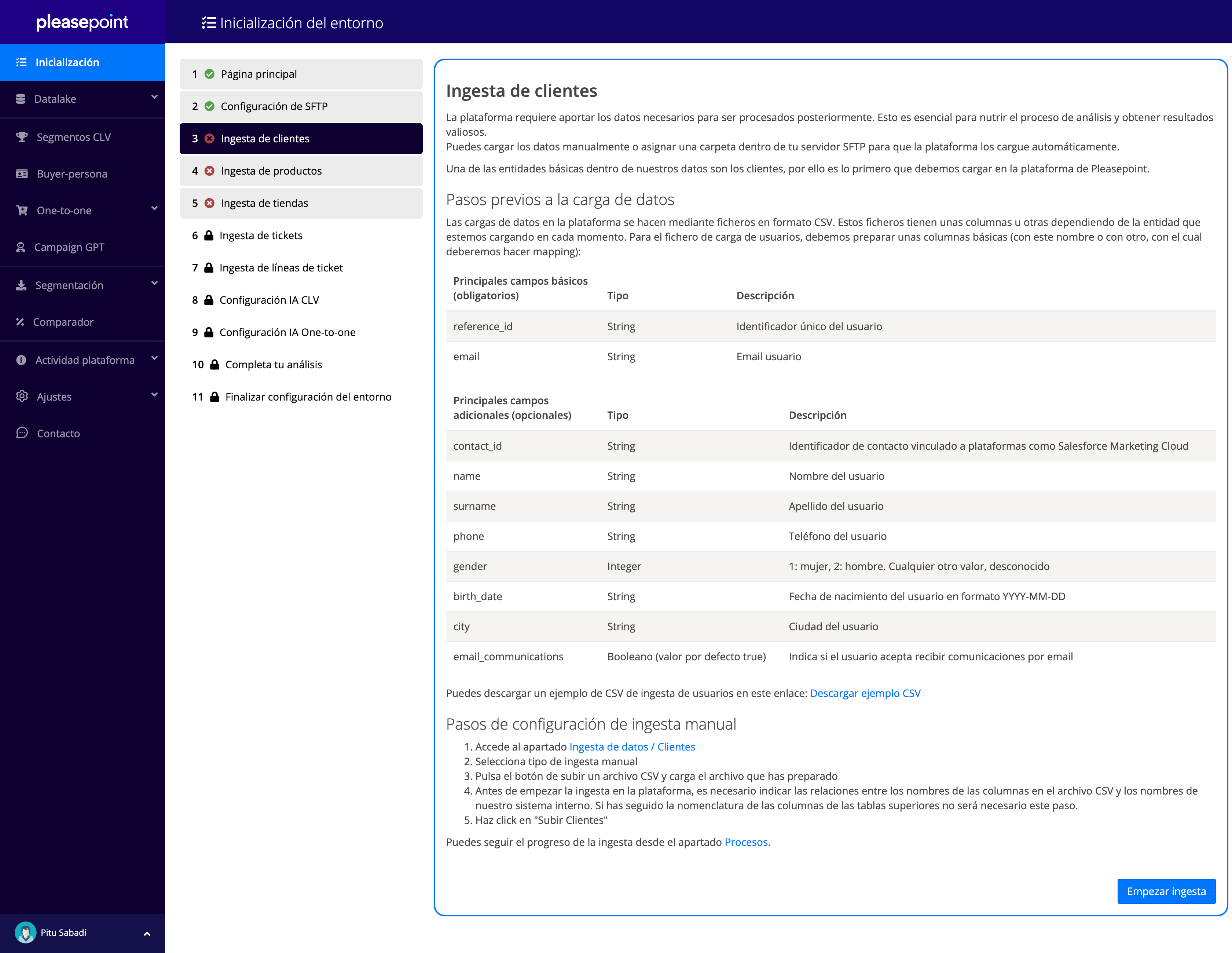
The platform requires you to provide the necessary data for subsequent processing. This is fundamental for fueling the analysis process and gaining valuable insights.
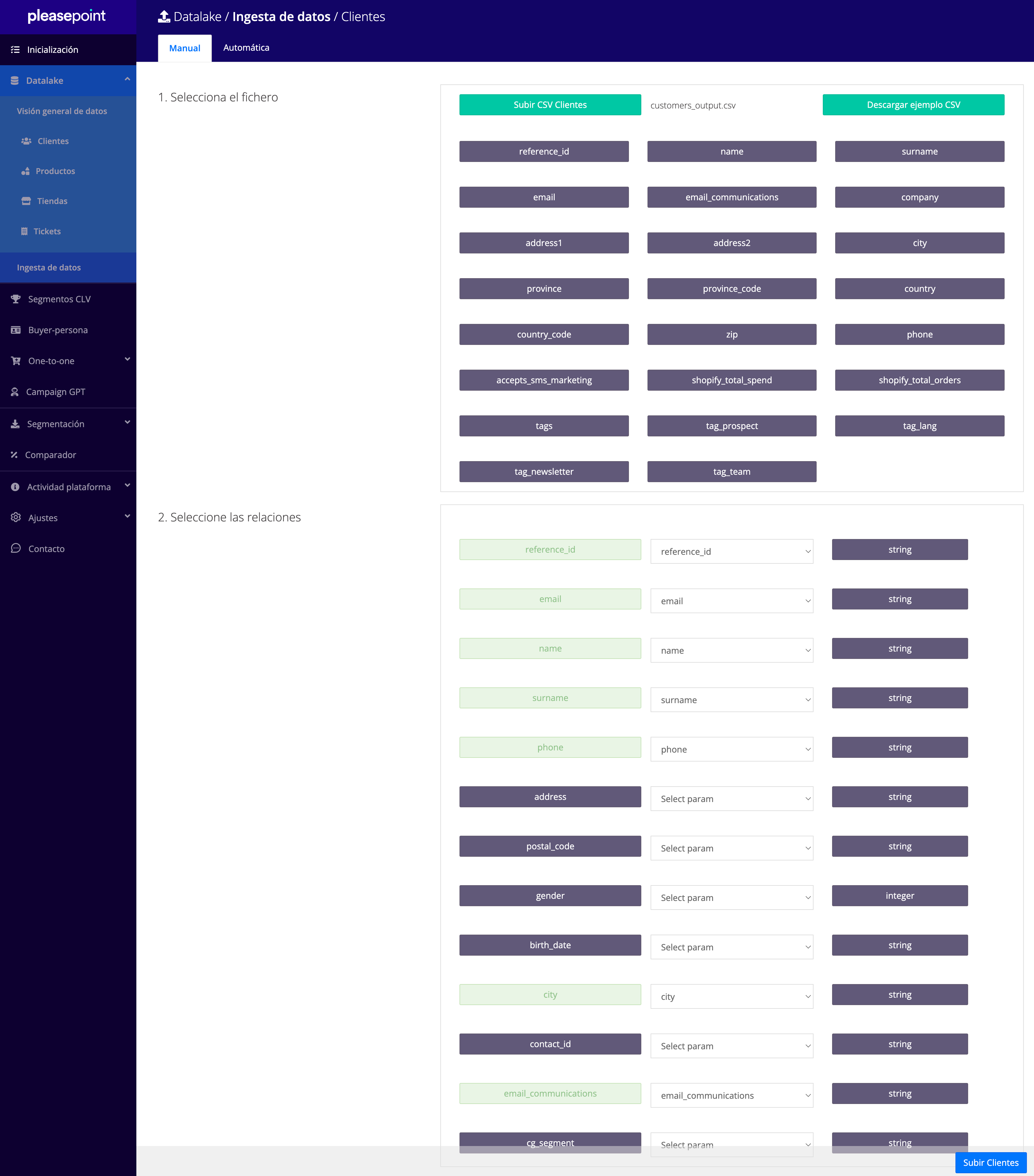
You can manually upload the data or assign a folder within your sFTP server for the platform to automatically load it. The initial customer data load is a crucial step as they form the basis of your analysis.
Step 4: Product Data Ingestion
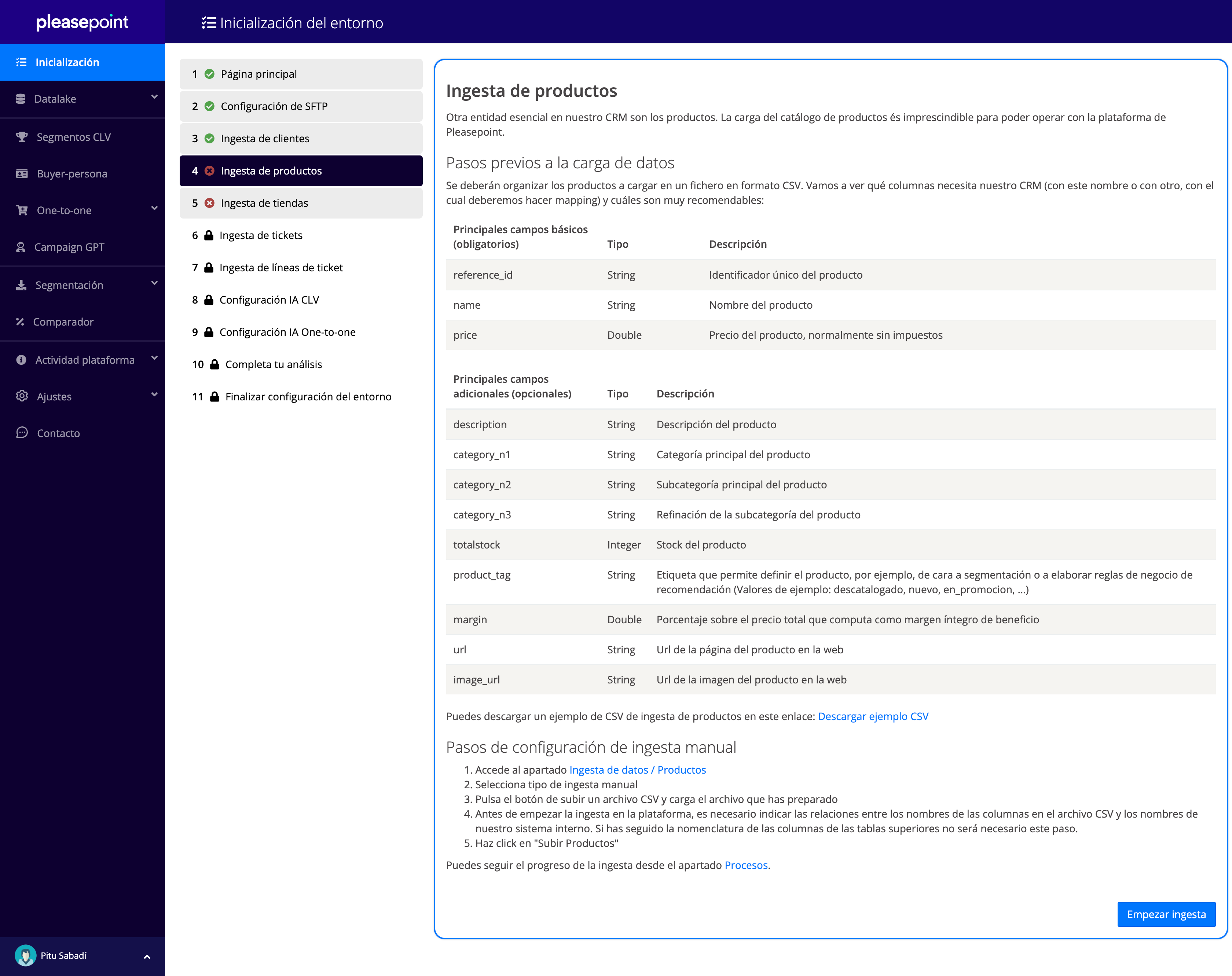
Products are essential in any CRM platform. Uploading your product catalog is critical to operating successfully on Pleasepoint. It is advisable to upload the historical product catalog and not just the current product feed.
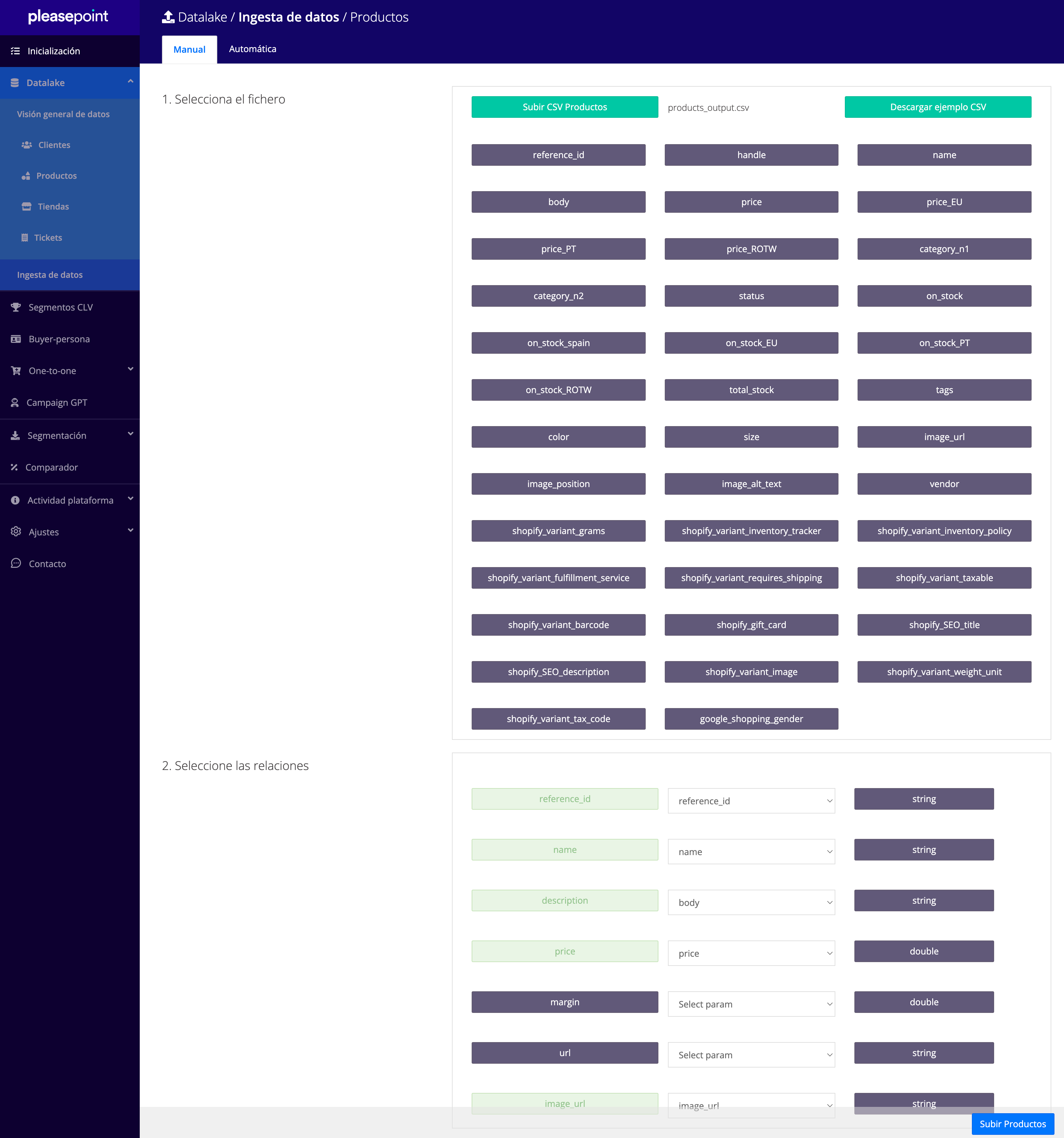
Organize your products in a CSV file and make sure to include the necessary columns. This will ensure that the platform can effectively use this data.
Step 5: Store Data Ingestion
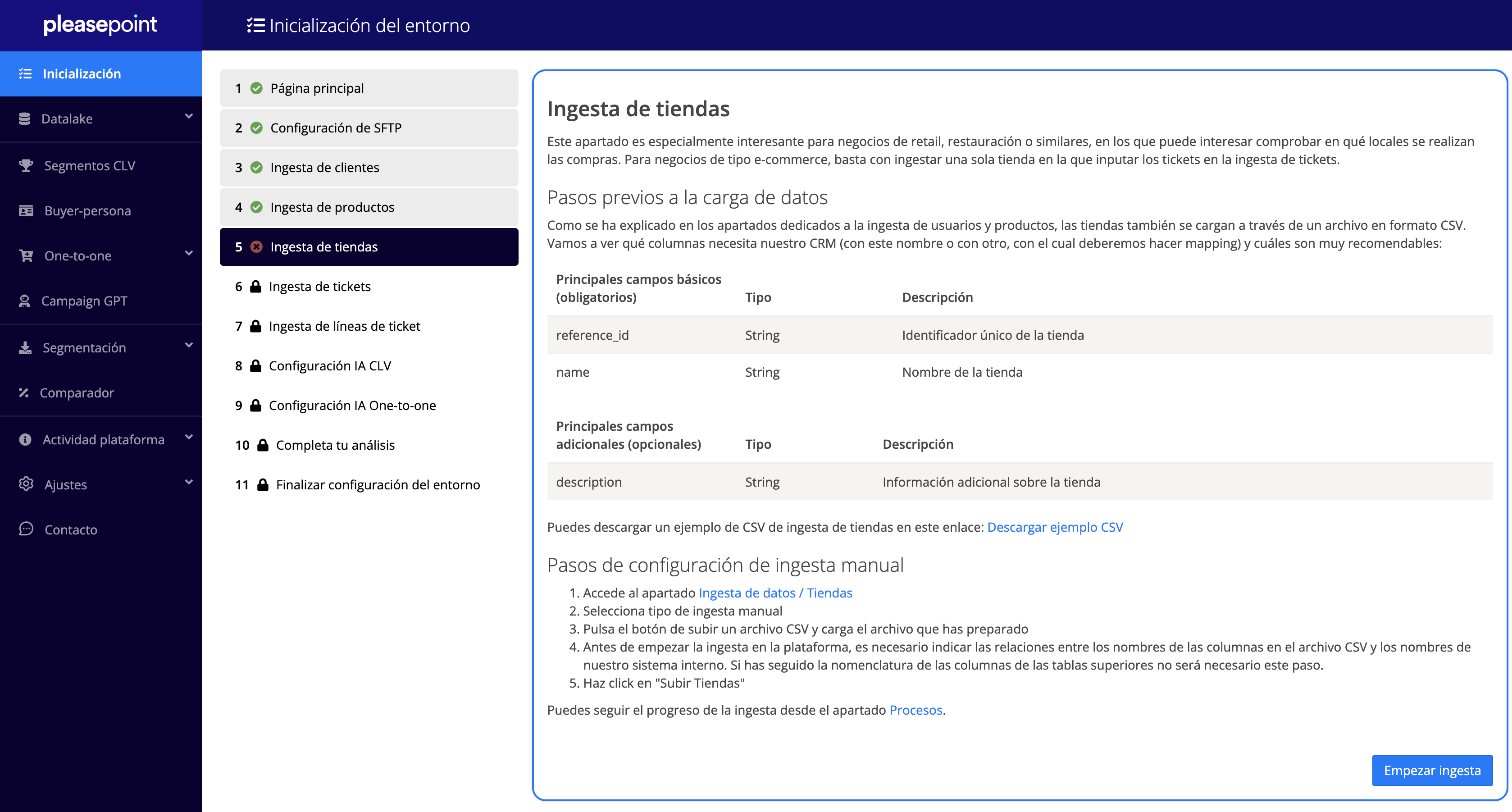
If your business includes multiple locations, such as retail or hospitality, store ingestion is important. For eCommerce businesses, one store is enough to record transactions.
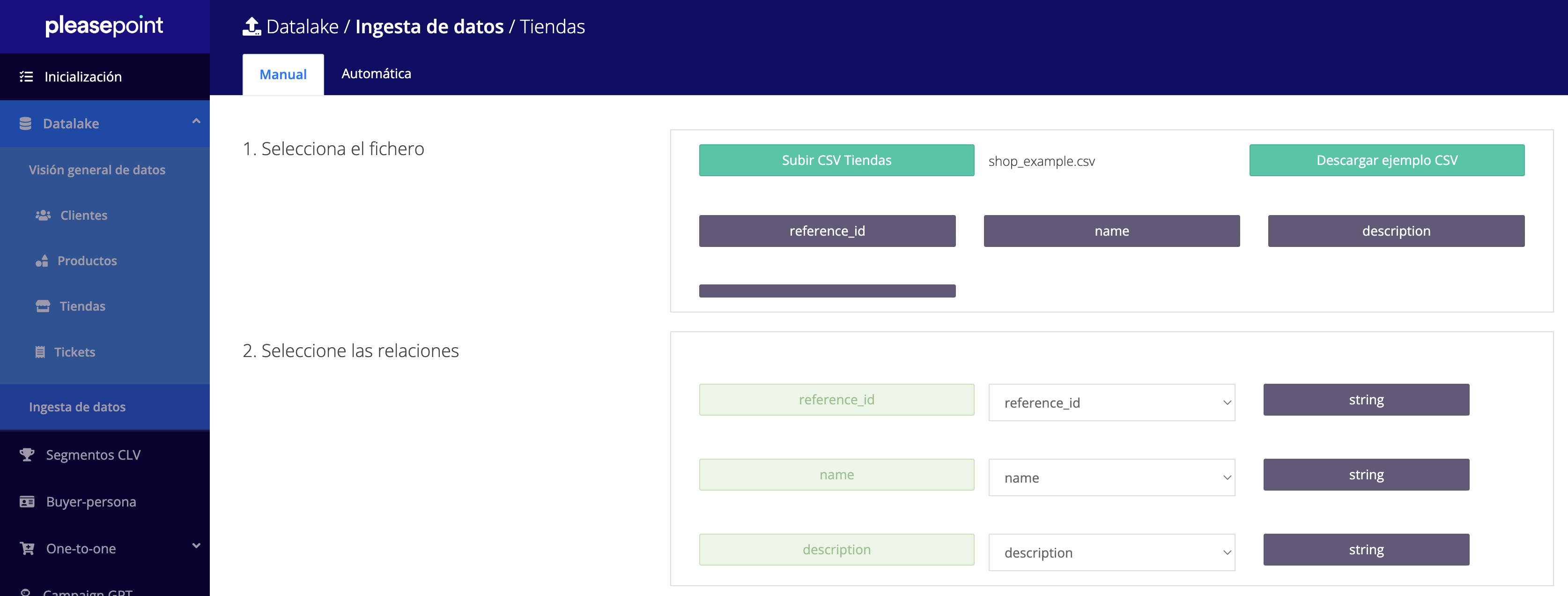
Stores are also uploaded via a CSV file, so it is crucial to have the correct columns set up.
Step 6: Ticket Data Ingestion
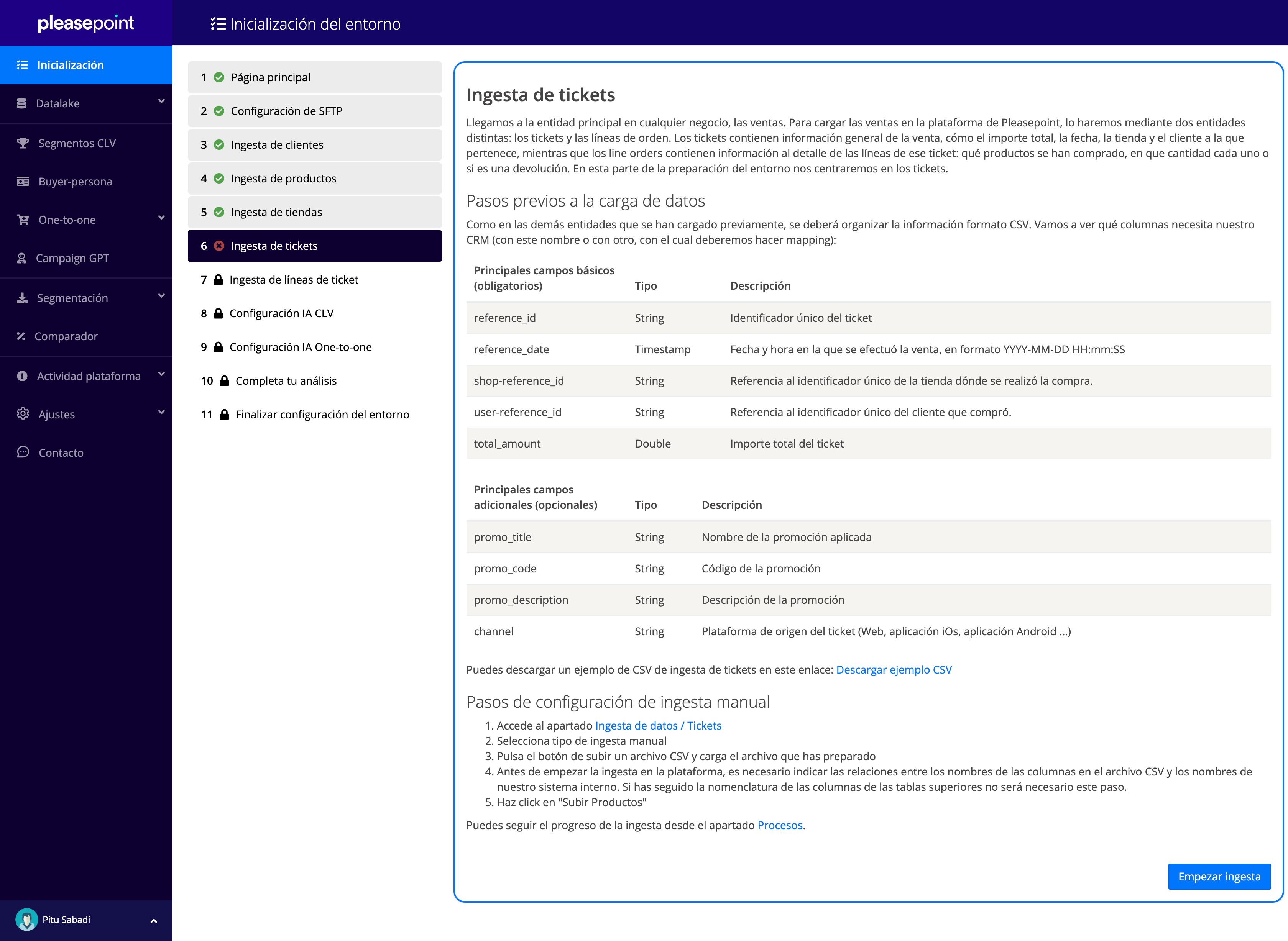
We arrive at the main entity in any business: sales. Pleasepoint allows you to upload sales through two distinct entities: tickets and line items.
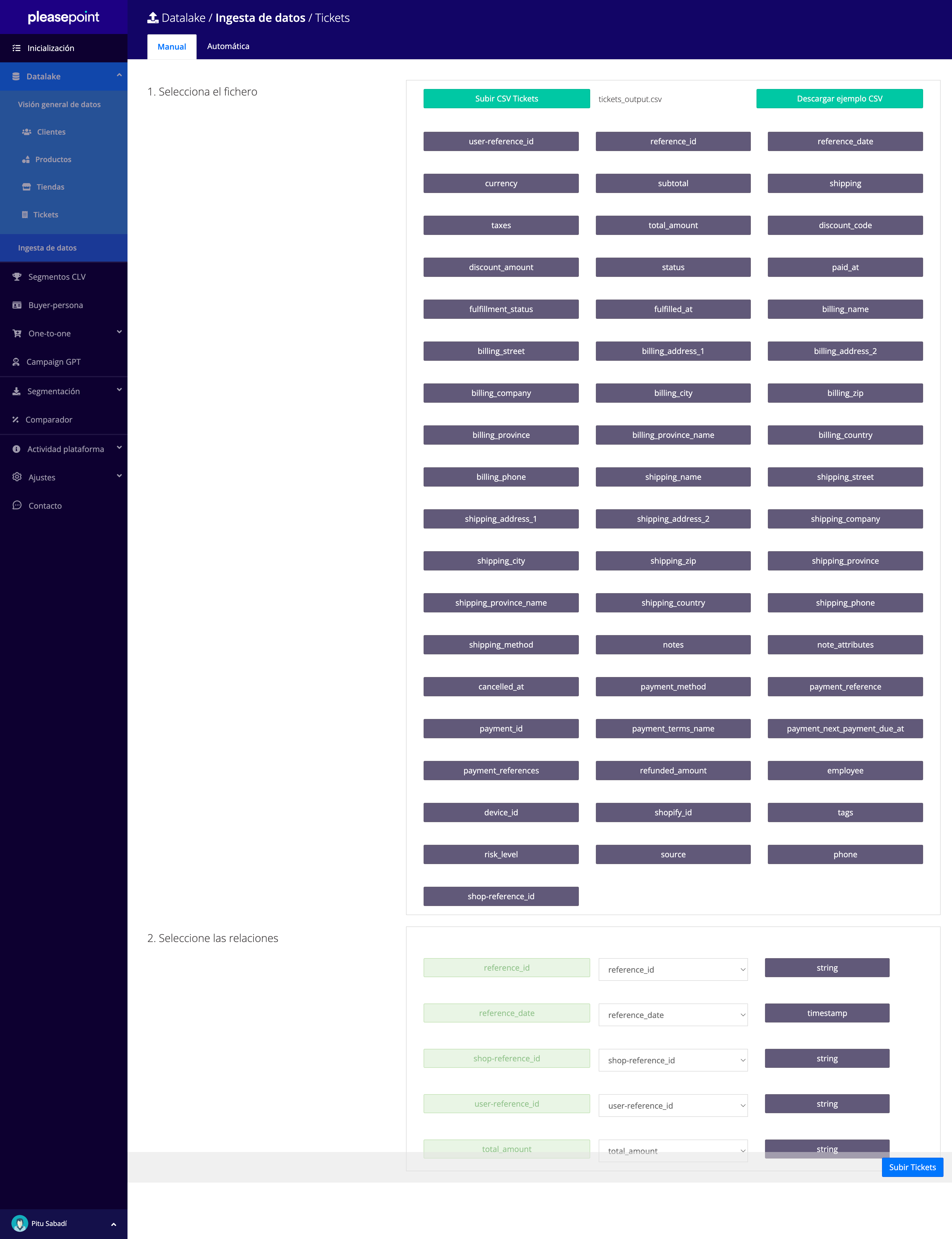
Tickets contain general information about the sale, such as the total amount, date, store, and the customer to whom it belongs. This is essential to understanding the overall picture of your sales.
Step 7: Ticket Line Data Ingestion
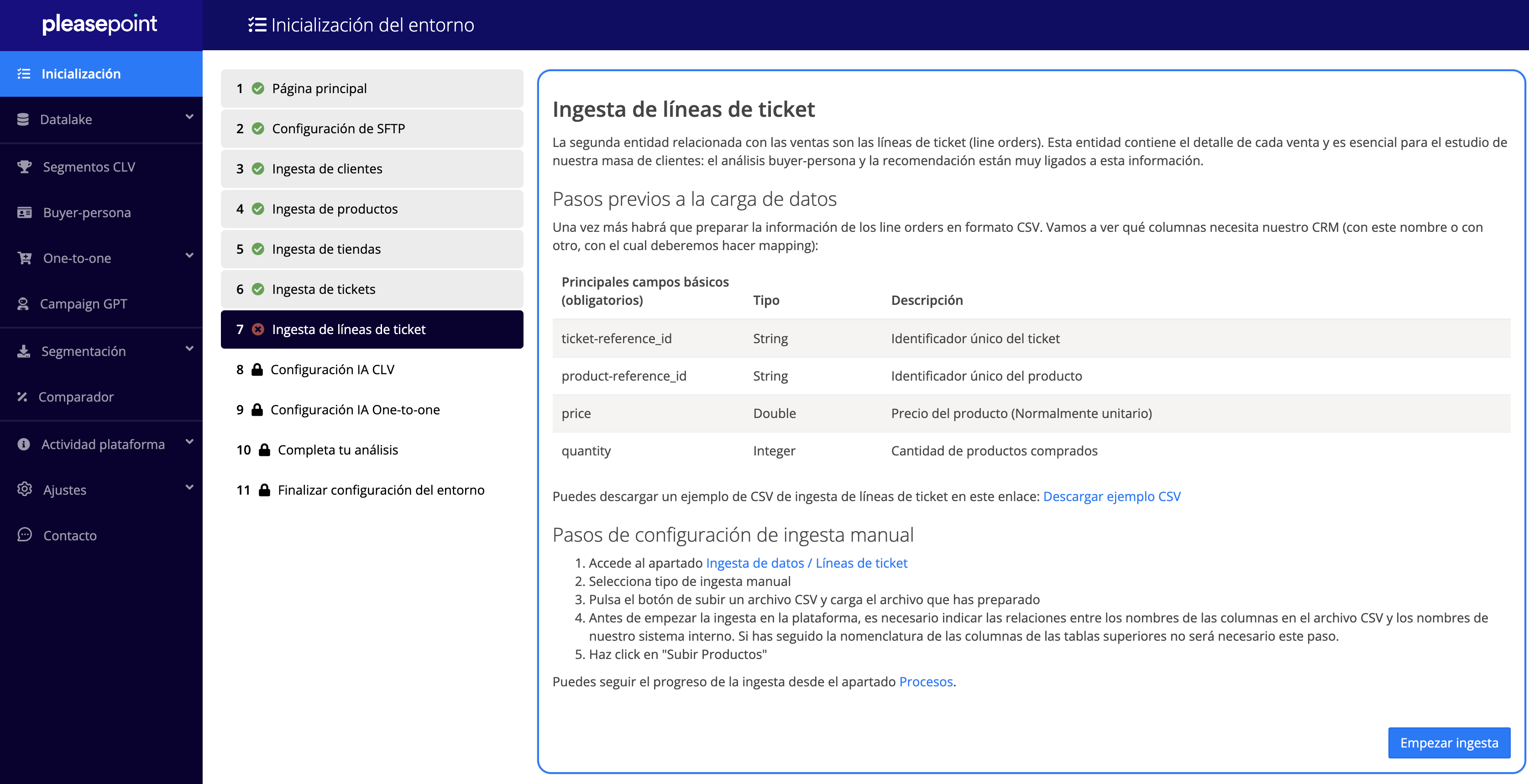
Ticket lines (line orders) are essential for more detailed analysis of your sales. They contain specific information about what was purchased, in what quantity, and if there were returns.
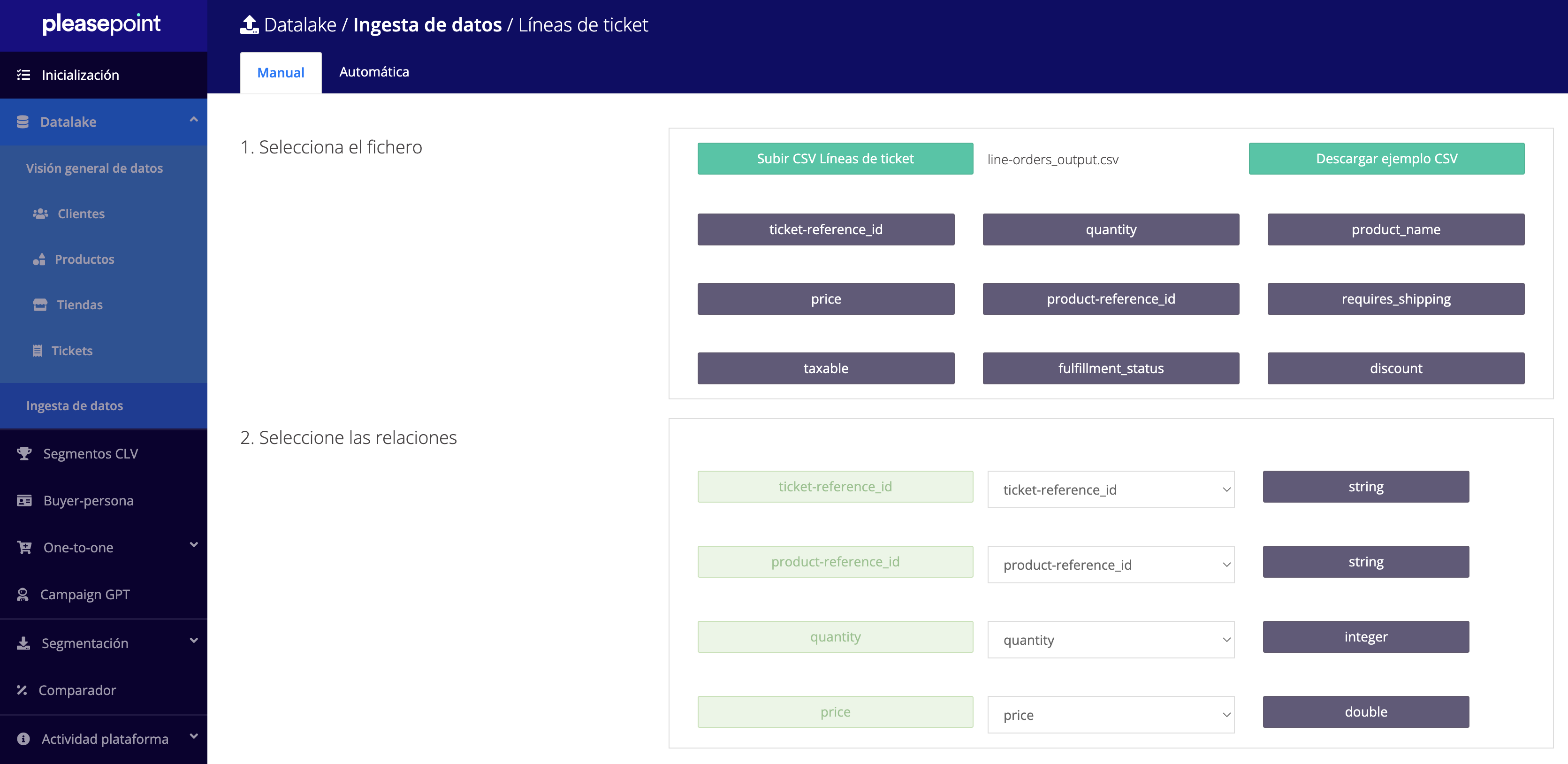
This is vital for buyer persona analysis and generating accurate recommendations.
Step 8: CLV Model Setup
Customer Lifetime Value (CLV) is a key metric for understanding the value of your customers over time. Pleasepoint allows you to calculate CLV by configuring a few simple parameters. This is crucial if you want to improve your sales and marketing strategies.
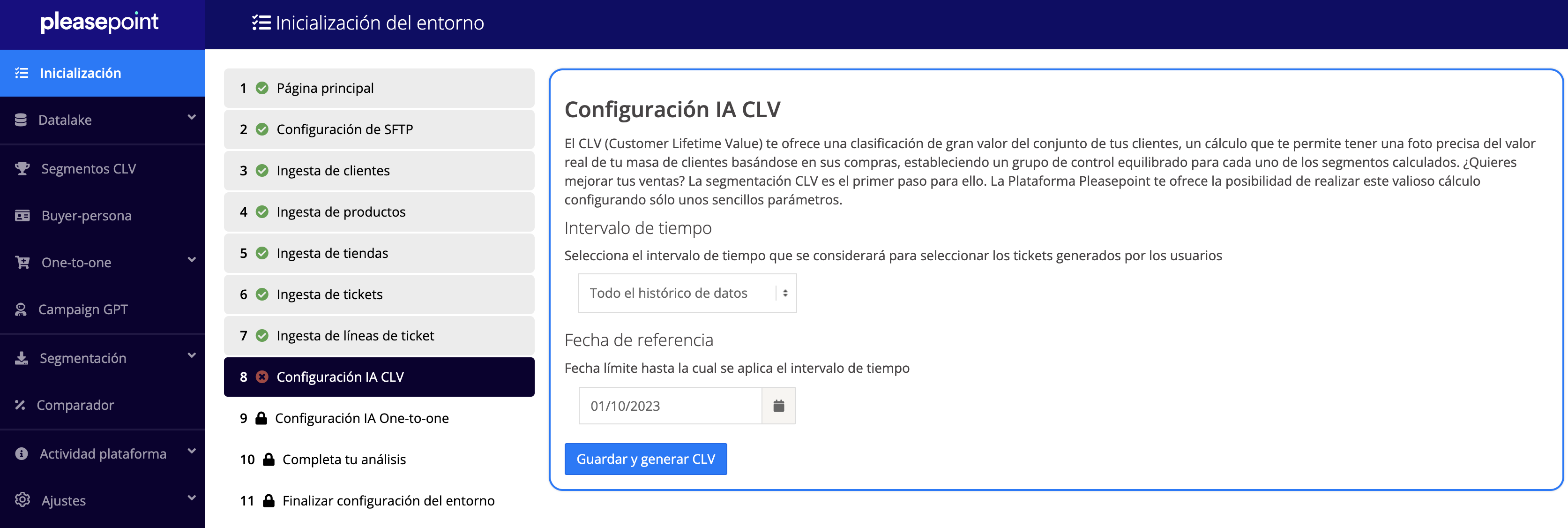
Step 9: One-to-One Recommendation Model Setup
One of the most powerful features of Pleasepoint is the One-to-One, which generates product recommendations using advanced artificial intelligence algorithms. You can run recommendations for user groups or provide real-time recommendations on your website. This will significantly increase your sales.
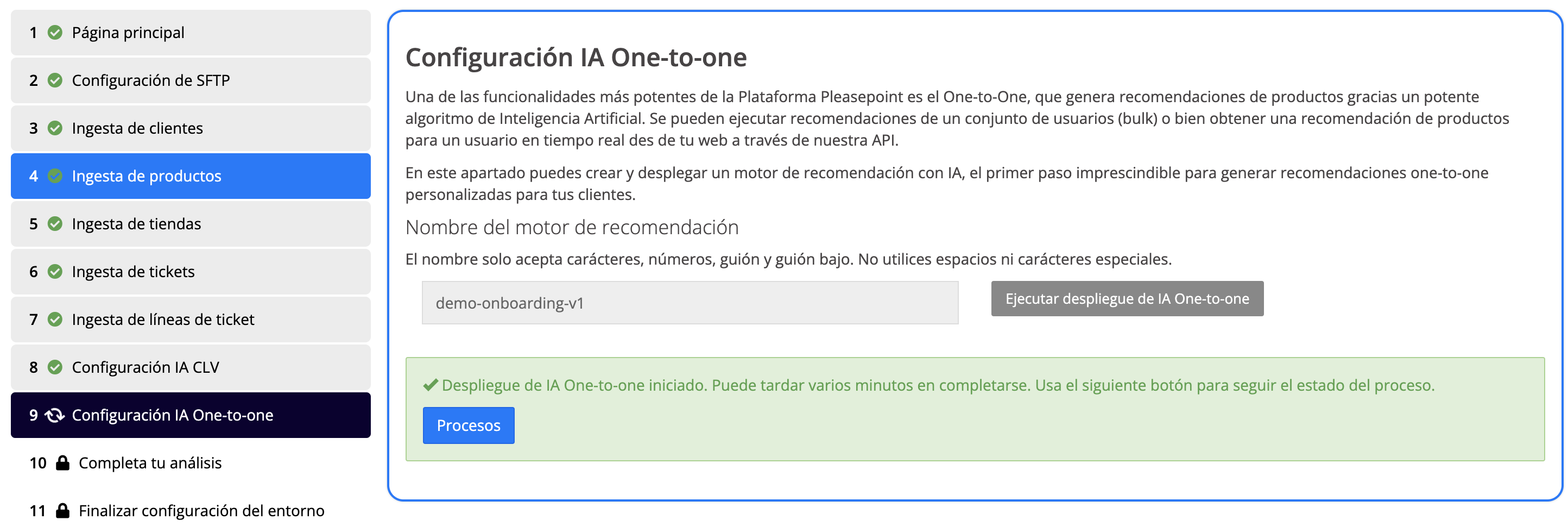
Step 10: Complete the Analysis
Once you've completed the setup, it's time to perform the analysis. Calculate general statistics and KPIs, and create necessary customer segments. This will help you better understand your audience and make data-driven decisions.
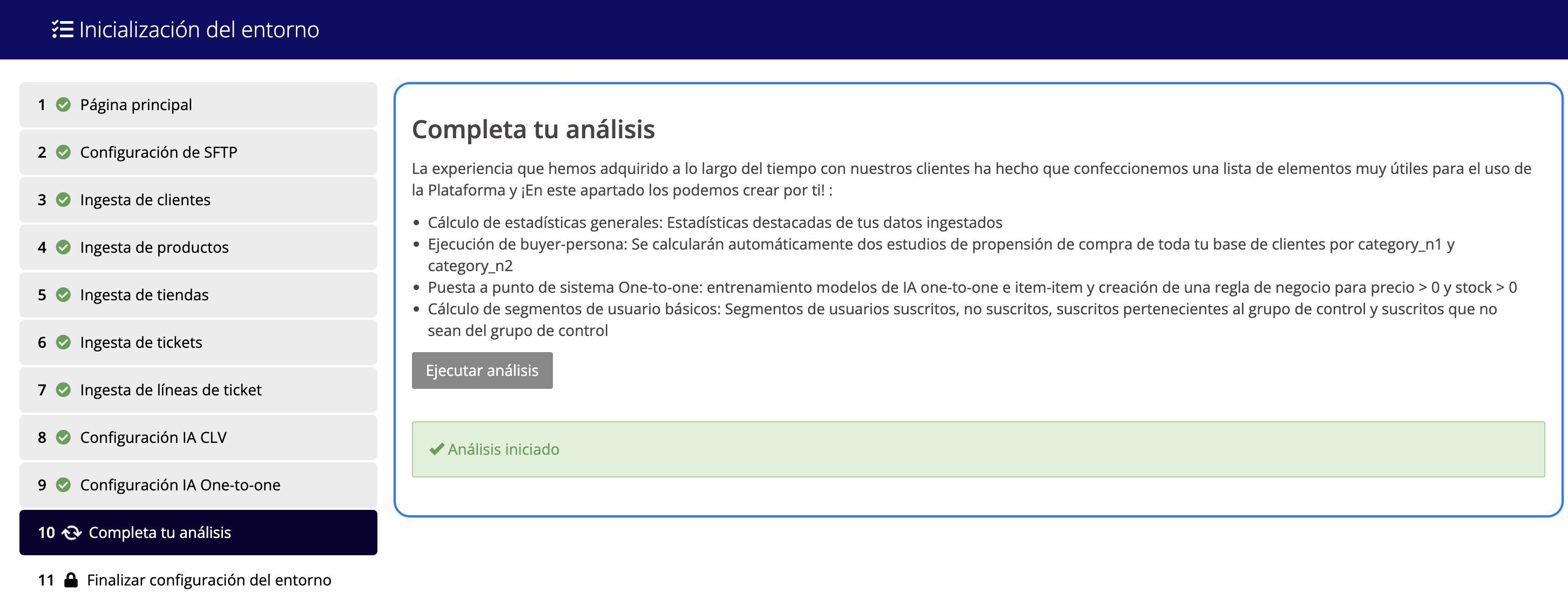
This step is essential to fully implement all the artificial intelligence models and get the most out of Pleasepoint.
After completing the analysis, you will automatically have available:
- General consumption statistics, RFM, lifecycle, top products, GDPR, etc.
- Customer classification model based on purchase propensity towards the first and second level of product categories.
- Product recommendation model including one-to-one, item-item, ranking, and bestsellers recommendations.
- Creation of customer segments: subscribed, non-subscribed, impactable subscribed, and control group subscribed.
Step 11: Finalize the Environment Setup
At this point, you will be ready to start micro-segmenting your customers and hyper-personalizing your interactions. You have effectively configured the platform, and now you can take full advantage of Pleasepoint's predictive marketing capabilities.
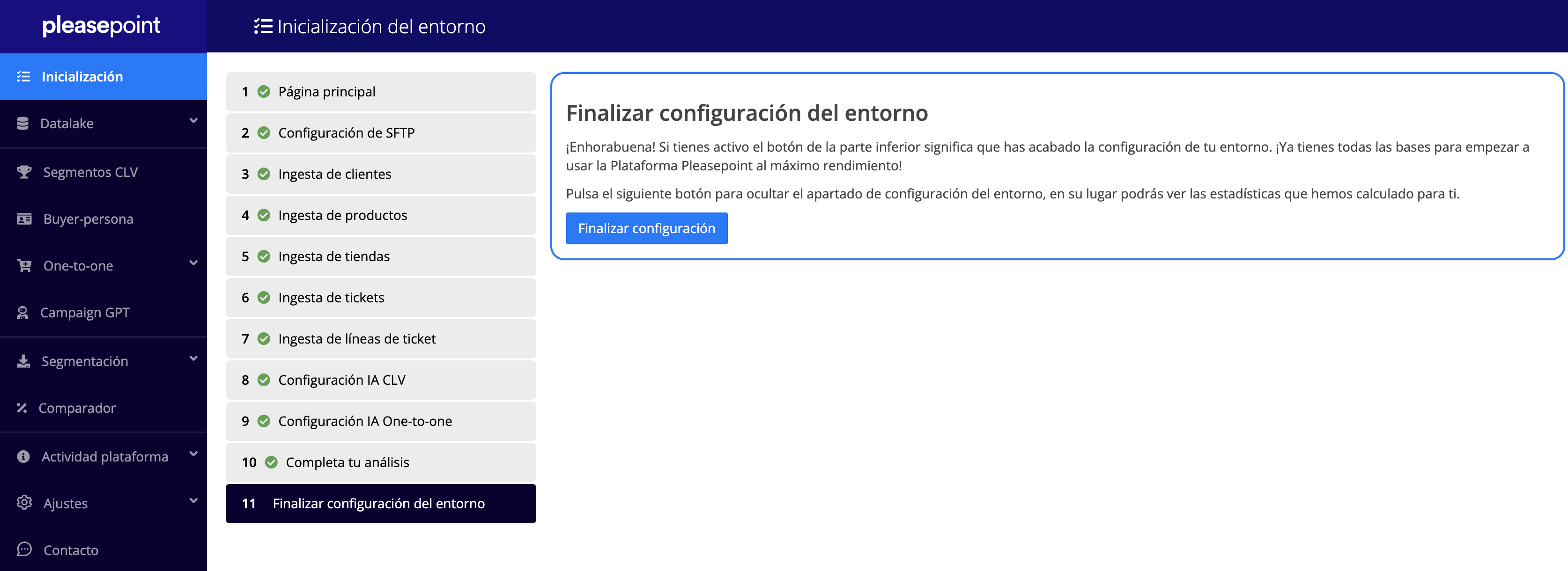
This onboarding process is a starting point toward a more effective and personalized marketing strategy. With Pleasepoint, you're on the right track to improving your sales and customer satisfaction.
Available Artificial Intelligence models after onboarding.
Upon completing the onboarding process in Pleasepoint, a series of artificial intelligence models become available to you, ready to be used in both customer segmentation and real-time interactions. These models are designed to help you boost your predictive marketing strategy and enable you to make more informed decisions.
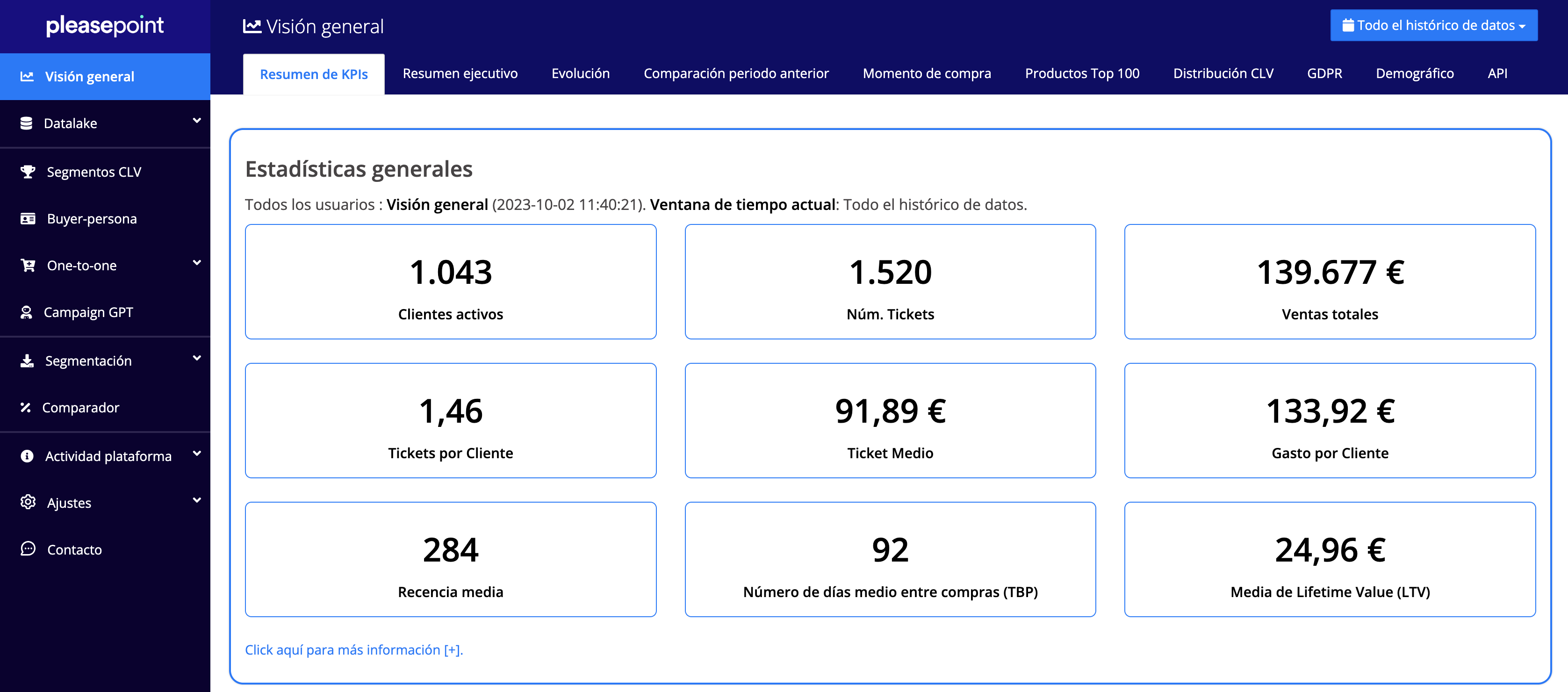
Additionally, from this moment on, the main consumption KPIs are calculated, both at a general level and for basic customer segments.
1. Segmentation Based on CLV (Customer Lifetime Value).
This model is a key piece for understanding your customers. It classifies your customers into different categories based on their loyalty status. You can identify recent customers, those who are hibernating, those who may be at risk of churning, those in the process of becoming loyal, and, of course, your most loyal and VIP customers.
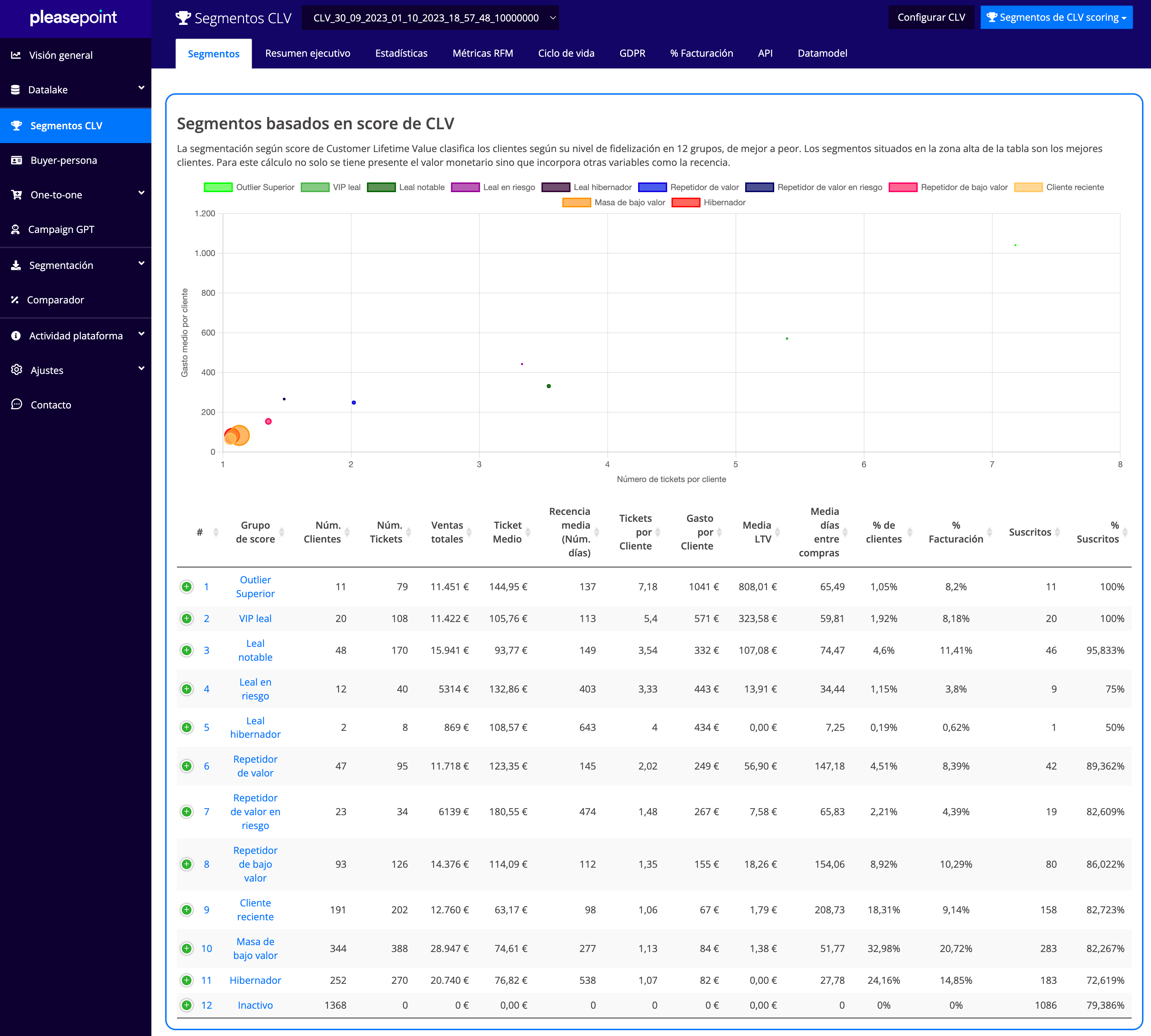
This segmentation provides valuable insights to adapt your marketing and retention strategies for each group.
Remember that the Customer Lifetime Value-based customer classification model also automatically generates a homogeneous control group of customer quality. In this post, we show you how to generate and use the control group to easily measure results.
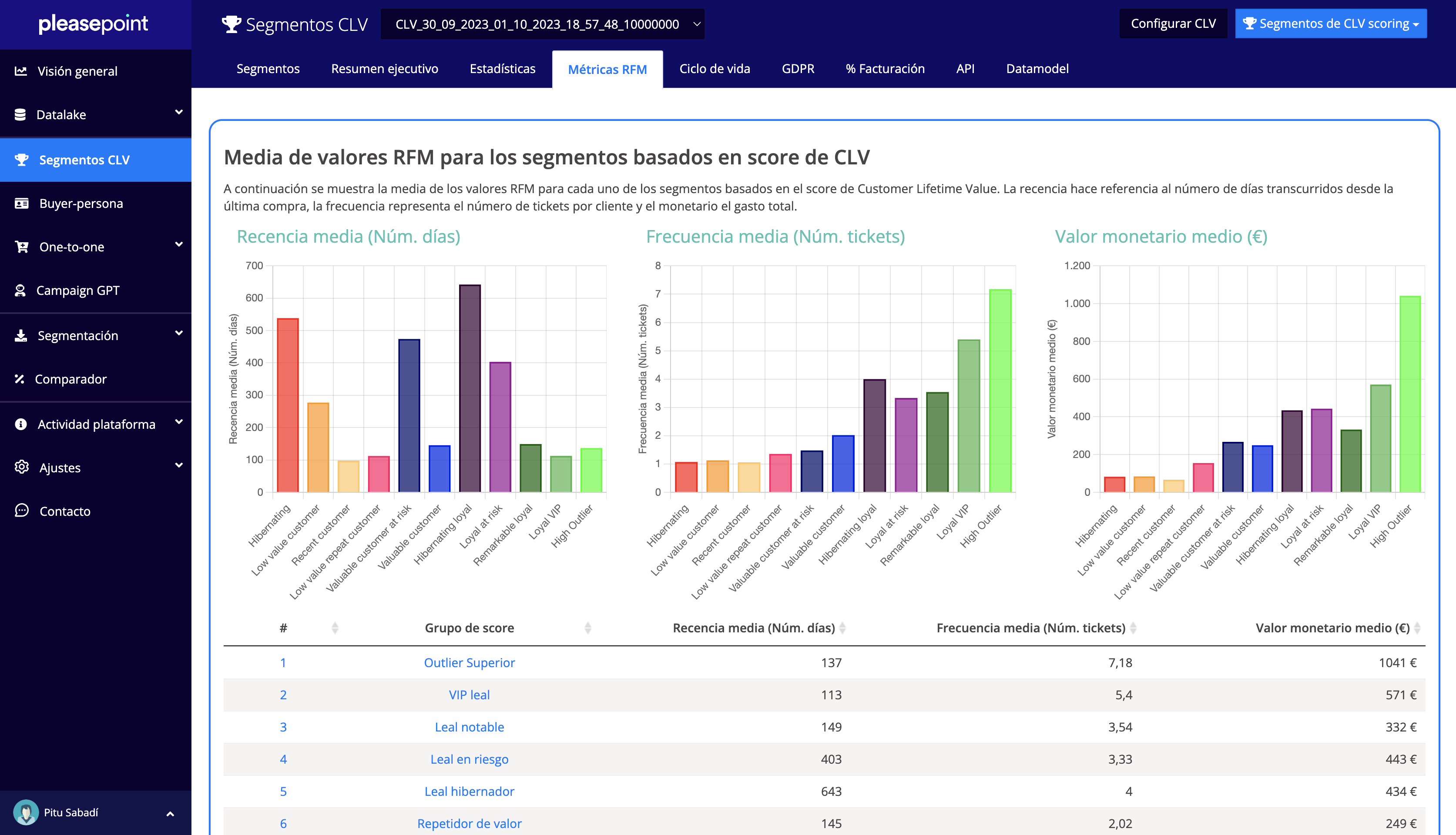
If you want to start using Customer Lifetime Value-based customer segmentation, we recommend this post from our predictive marketing blog.
2. Buyer Persona Models.
Here, Pleasepoint offers two purchase propensity models. The first level of product categories helps you understand which product categories are most likely to attract certain customer groups. The second level delves deeper into your customers' purchase preferences, allowing you to create audiences with similar purchase propensities and direct them towards specific product categories.
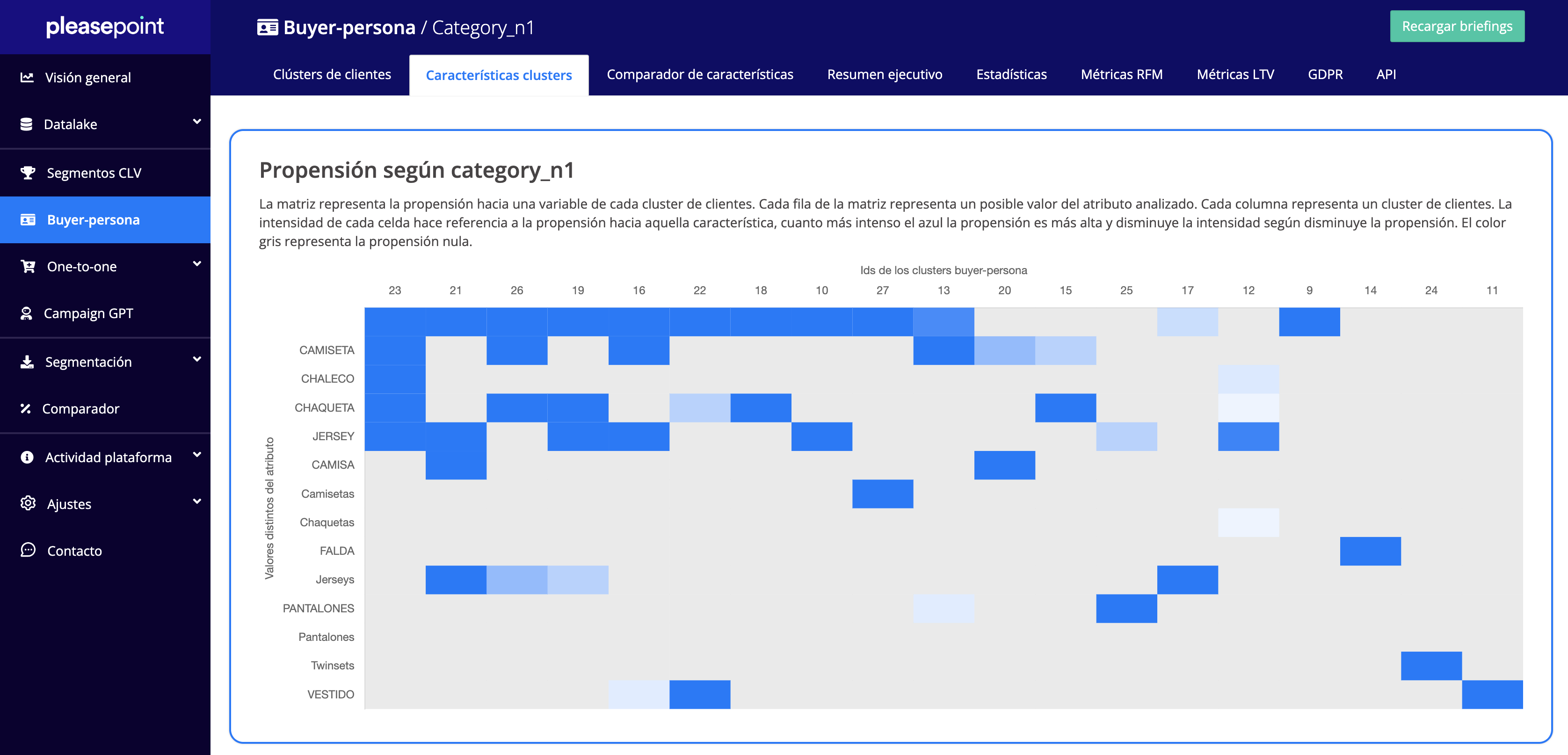
The screenshot shows how customers are distributed based on their purchase propensity toward different product categories. Each column is a customer cluster (customers are in one, and only one, cluster), and each row is a product category. The higher the color intensity of the cell, the higher the propensity for that category; the gray color indicates no propensity.
One highlight is that you can easily implement new buyer persona models, giving you flexibility to adapt them to your changing needs.
If you want to start using purchase propensity models, we recommend this post from our predictive marketing blog.
3. One-to-One Product Recommendation
Product recommendation is a powerful strategy to increase sales and improve the customer experience. Pleasepoint uses a recommendation engine powered by a neural network enhanced with reinforcement learning (deep learning) to offer each customer the best product selection in real time.

You have access to four recommendation models:
- User-Item: Recommendations based on each user's preferences.
- Item-Item: Recommendations based on product similarity.
- Ranking: Displays a ranked list of recommended products.
- Bestsellers: Highlights the most popular products among your customers.
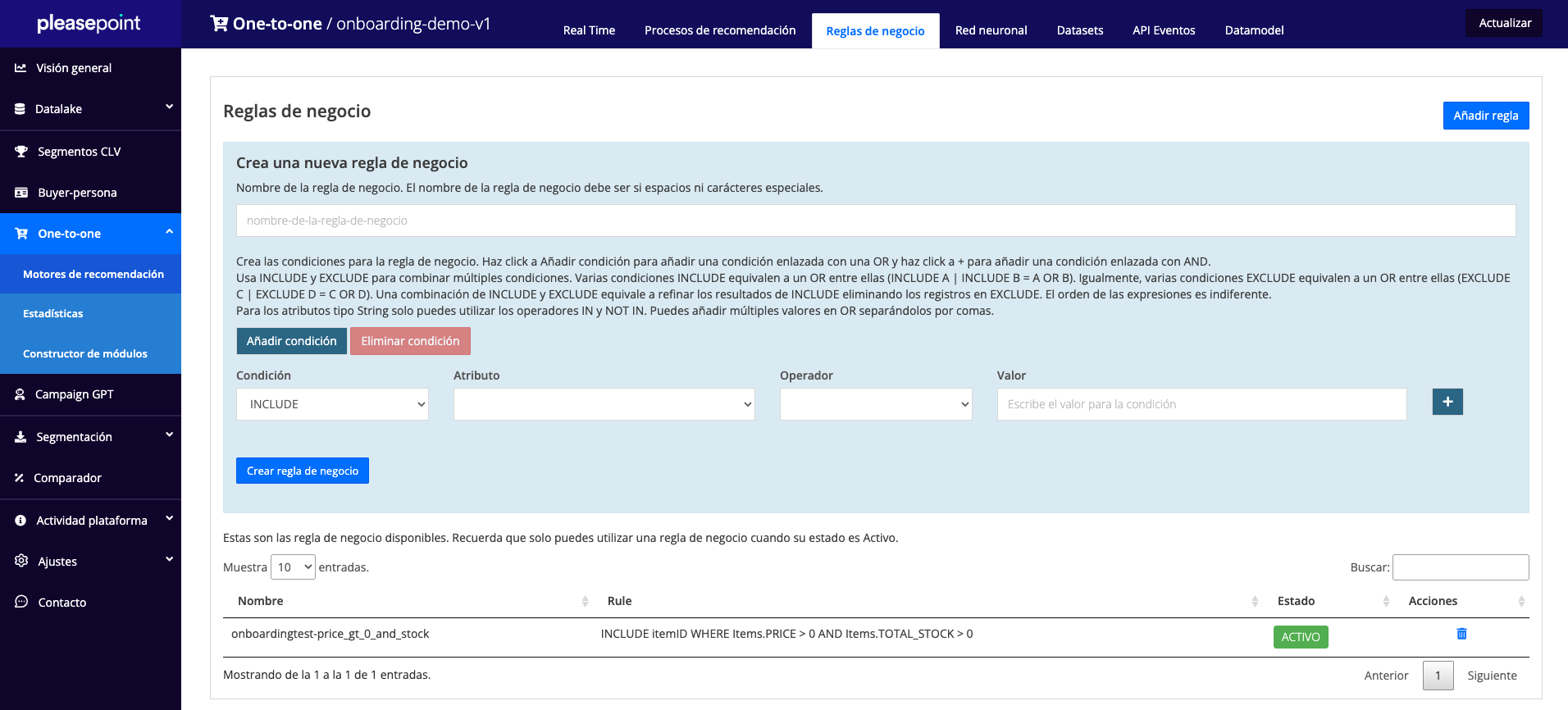
A first business rule for product recommendation has also been created. Remember that you can use business rules to guide the commercial strategy of recommendations.
If you want to start using one-to-one recommendations in your CRM strategy, we recommend this post from our blog.
These artificial intelligence models allow you to personalize your marketing strategies, adapting them to your customers' individual needs and preferences. Whether segmenting customers based on their lifetime value, understanding their purchase propensities, or accurately recommending products, Pleasepoint provides you with the tools needed to implement an effective predictive marketing strategy and deliver an exceptional customer experience.
4. Basic Customer Segments
In addition to the models above, Pleasepoint provides predefined segments to simplify your strategy. These segments include subscribed, non-subscribed, subscribed control group non-impactable, and subscribed control group impactable.

You can leverage these segments in buyer persona models and one-to-one recommendations, as well as in the comparator to measure sales increases.
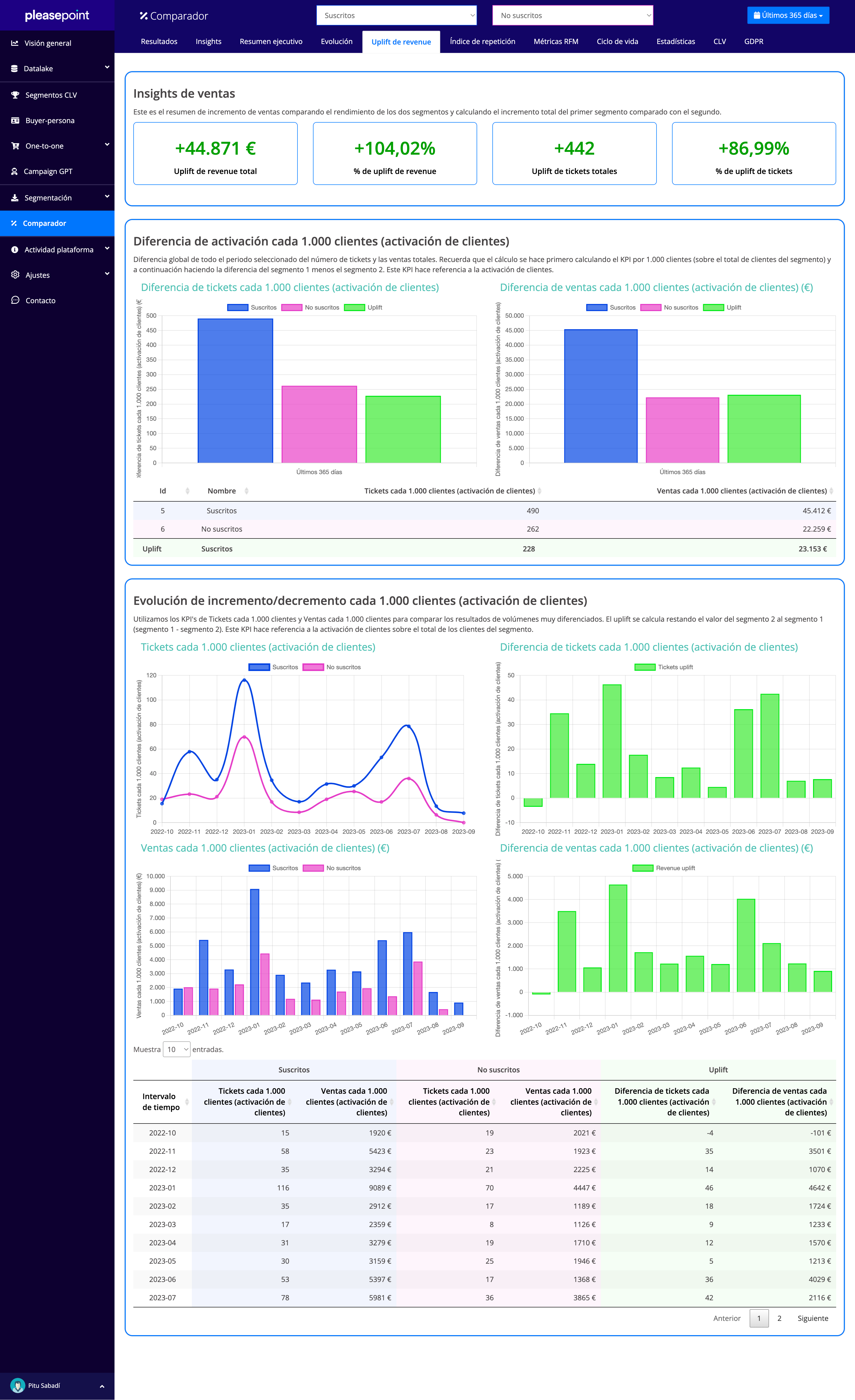
Start now by implementing these use cases.
Artificial Intelligence (AI) is a revolutionary tool that can radically transform your marketing strategy. With Pleasepoint, not only can you leverage AI to improve your marketing campaigns, but you can also take hyper-personalization to the next level.
If you think now is a good time to start personalizing, let me share this success case: In this post, we show the results of one of our clients from August.
Here are a series of use cases that show how you can use Pleasepoint's AI to multiply the return on your marketing actions and provide highly personalized customer experiences in real-time:- Personalized Newsletters Based on Purchase Propensity: Use Pleasepoint's AI to analyze your customers' behavior and determine their purchase propensity. Then, tailor your newsletters based on this information. This involves sending offers and content that align with each customer's individual interests and needs, which can significantly increase open and click-through rates.
- Personalized Newsletters and Campaigns with One-to-One Product Selection: Pleasepoint's AI allows you to recommend specific products to each customer in your newsletters and campaigns. Instead of sending a generic set of products, you can select individualized products based on each customer's purchase history and preferences.
- Micro-Segmented Campaigns Based on Loyalty Status: Recognize your loyal customers and those at risk of leaving. Pleasepoint's AI allows you to create specific campaigns to retain your loyal customers and re-engage those who may be losing interest. Proper segmentation is key to maximizing the effectiveness of your messages.
- Customer Journeys Based on Loyalty Status Evolution: Each customer is at a different stage in their relationship with you. Pleasepoint's AI allows you to create personalized journeys to guide customers from their first interaction with your brand to long-term loyalty, all based on their loyalty status evolution.
- Micro-Segmented Campaigns Based on Purchase Propensity: Identify customers most inclined to make a purchase and target specific campaigns to capitalize on this propensity. This increases the chances of conversion and maximizes your return on investment.
- Customer Journeys for Repeat Purchases Based on Purchase Propensity: Encourage repeat purchases through personalized journeys based on your customers' purchase propensity. Offer incentives and relevant content to keep customers engaged and encourage additional purchases.
- Customer Journeys for Cross-Selling Based on Purchase Propensity: Increase the average value of each purchase by making strategic recommendations based on purchase propensity. Pleasepoint's AI can identify cross-selling opportunities and create customer journeys that encourage these additional purchases.
- Better-Segmented Audiences and Personalized Ads in Digital Advertising: It's not just about your email campaigns. Pleasepoint's AI also allows you to precisely segment in digital advertising. Target highly relevant ads to specific audiences to improve the effectiveness of your online advertising campaigns.
- Real-Time Hyper-Personalization of the eCommerce Home Page: By using AI, you can personalize your online store's homepage in real-time. This means that each visitor will see a homepage designed specifically for them, based on their purchase propensity and one-to-one product recommendations.
- Real-Time Hyper-Personalization of eCommerce Product Listings: When a customer browses your products, Pleasepoint's AI can dynamically adjust product listings based on their behavior and preferences, increasing the likelihood of finding relevant products and making a purchase.
- Real-Time Hyper-Personalization of the eCommerce Product Page: Each product page can be personalized in real-time according to the customer visiting it. This means showing specific product recommendations based on each user's purchase propensity and browsing history.
- Real-Time Hyper-Personalization of the eCommerce Cart Page: Even the cart page can be adapted in real-time to drive additional sales. Offer complementary product suggestions or specific promotions based on the customer's purchase propensity.
These use cases demonstrate how Pleasepoint's AI allows you to create highly personalized customer experiences at every touchpoint, from emails to your online store, leading to greater engagement, conversions, and customer retention. With Pleasepoint, hyper-personalization is accessible and effective.
By personalizing and automating your communications based on purchase propensity, you position yourself advantageously in today's highly competitive market.
Download our eBook Enriching customer data and learn to execute a personalization strategy based on the lifecycle and preferences of each of your customers. It's never been easier to start hyper-personalizing and increasing the performance of your marketing actions.
